| home > 2012 financial > statutory > Notes to the Parent Company financial statements |
home > 2012 financial > statutory > Notes to the Parent Company
financial statements
Notes to the Parent Company financial statements
1) Activity of the company
RAI-Radiotelevisione Italiana SpA (hereinafter Rai) is exclusively assigned the public service broadcasting of radio and television
programmes.
The Company may enlist the aid of subsidiaries for activities relating to the performance of the pertinent services. Rai is also
allowed to perform commercial and publishing activities connected to the dissemination of pictures, sound and data, as well
as other related activities, either directly or through associated companies, as long as these activities do not influence the best
pursuit of the public services for which it holds the concession and contribute to balanced company operation.
Rai’s operations must be conducted in compliance with the applicable regulations in force contained in Law 103 of 14 April
1975 (“New regulations governing radio and television broadcasting”), Law 223 of 6 August 1990 (“Regulation of the public
and private radio and television system”), the “Measures governing the concession holder for the public radio and television
broadcasting service” issued with Law 206 of 25 June 1993 and subsequent amendments, Law 249 of 31 July 1997 on the
“Establishment of the Communications Authority and regulations governing telecommunications and the radio and television
system” and Law 112 of 3 May 2004 (“Regulations establishing principles for the organization of the radio and television
system and RAI-Radiotelevisione Italiana SpA, as well as granting authority to the Government to issue a consolidated radio
and television law”). With Legislative Decree 177 of 31 July 2005 approval was given to the” Consolidated Broadcasting
Law”, which was amended and renamed “Consolidated Broadcasting Law” by Legislative Decree 44 of 15 March 2010, incorporating
additional clauses, amendments and cancellations necessary for the co-ordination of the services or their proper
implementation. The Consolidated Law also contains the provisions of Law 112/04, relating to the radio and television general
public service and, consequently, articles 3 and 5 of Law 206/93 not repealed by Law 112/04.
The general public radio and television service concession is assigned to Rai until 6 May 2016, on the basis of Consolidated
Law governing audio-visual and radio media services, issued with article 49 of the Legislative Decree 177 of 31 July 2005.
Article 45 of the same Consolidated Law envisages that the general public radio and television service be provided by the
concession holder on the basis of a National Service Agreement lasting three years, entered into with the Italian Ministry of
Communications, identifying the rights and obligations of the concession holder.
The new service agreement for 2010-2012 was entered into between the Ministry of Economic Development and Rai on 6
April 2011 and was approved with ministerial decree of 27 April 2011, published in Official Gazette of 27 June 2011.
The rationale underlying the above regulatory framework lies in the public interest functions entrusted to the concession holder.
Under these regulations, Rai has special institutional characteristics and operating constraints, in addition to the specific
obligations undertaken with the Service Contract.
2) Introduction
The Parent Company financial statements at 31 December 2012 are prepared in conformity to the relevant provisions of the
Italian Civil Code. They are supplemented with annexes featuring the reclassified statements comprised of tables for the analysis
of the balance sheet and income statement, and of cash flows.
The financial statements are expressed in euros, without decimals; the Notes to the financial statements and the related detailed
Schedules are stated in thousands of euros.
Rai’s financial statements have been audited by PricewaterhouseCoopers SpA.
3) Accounting policies
Before examining the individual items, we have provided an overview of the main accounting policies used in drafting the
financial statements, which were adopted from the perspective of the Company as a going concern and comply with the
provisions of Articles 2423 et seq. of the Civil Code. These policies are unchanged from those applied in the preceding
year, with the only exception being the valuation of investments in subsidiaries and associated companies which, starting
from 2012, are valued using the equity method instead of the cost method, which was adopted until 31 December 2011.
The reasons for this change arise from the need to offer a better representation of the income statement, balance sheet and
financial situation and to increase the consistency of the Company’s equity, aligning the equity figures with those of the consolidated
financial statements.
At the time of first application, the higher values of the investments consequential to the profits gained in previous years with
effect on a specific non-distributable reserve for revaluation of equity investments were disclosed for an amount of 112,074
thousand euros, which represents the previous effect determined by the change in the accounting standard. The part of this reserve
realised during the year consequential to the distribution of dividends, equating to 551 thousand euros, was reassigned
to other available reserves.
The change in the criterion used to assess equity investments determined the following effects on the financial statements at
31 December 2012:
• increase in the value of equity investments: 132,767 thousand euros;
• higher result for the year: 20,504 thousand euros;
• increase in Shareholders’ equity: 132,767 thousand euros.
There are no exceptional cases requiring derogation from the requirements under Article 2423-bis et seq. of the Civil Code.
a) Industrial patents and intellectual property rights:
The acquisition and production costs of programmes, composed of external costs that can be allocated directly to each
project and the cost of internal resources used to create programmes, are recorded according to the following criteria:
1) costs for repeat-use television productions are capitalised under intangible assets and, if such productions are usable
at year-end, are carried under industrial patents and intellectual property rights and amortised on a straight-line basis
over the period of their estimated useful life. If such programmes are not yet usable at year-end, the costs are carried
under intangible assets under development and payments on account.
The objective difficulty of establishing an appropriate correlation between advertising revenues and licence fees and
the amortisation of the rights, which is further complicated by the many ways in which they can been used, has prompted
Rai to designate three years as the useful life of repeat-use programmes, represented by TV series, cartoons and
comedies, and four years for that of library exploitation rights for football events.
Costs for concession rights with a shorter duration are amortised over the period they are available.
In addition, an impairment provision has been established for programmes for which transmission, re-broadcasting or
commercial exploitation is at risk.
2) Costs for immediate-use television programmes are expensed in a single year, which is normally that in which they are
used. More specifically:
• News, light entertainment and all radio programming. Costs are expensed in the year in which they are incurred,
which is normally the year in which the programmes are broadcast.
• Sports events. Costs are booked to the year in which the event takes place.
• Documentaries, classical music and drama. Costs are charged against income in a single amount at the time the
programmes are ready for broadcasting or the rights are usable.
b) Software licences are carried with industrial patents and intellectual property rights net of amortisation and are amortised
over three years from the year they enter service.
c) Costs incurred for the construction of the digital terrestrial network are capitalised under intangible assets net of amortisation
and amortised on a straight-line basis over the forecast period of use from the date the service is activated.
d) Trademarks are amortised over ten years from the year they enter service.
e) Deferred charges are carried under other intangible assets net of accumulated amortisation. They regard improvements to
leased or licensed property and accessory charges on loans. Amortisation for leasehold improvements is determined on
the basis of the shorter of the residual duration of the related contracts and the estimated period of benefit of the costs,
calculated using amortisation rates which reflect the rate of economic deterioration of the relative assets. Accessory charges
on loans are amortised in relation to the duration of the loan.
f) Tangible fixed assets – which are shown net of accumulated depreciation – are recorded at cost, increased by internal
personnel costs incurred in preparing them to enter service, and revaluations pursuant to laws. The costs of non-current
assets as determined above are depreciated in accordance with Article 2426 (2) of the Civil Code. Ordinary maintenance
costs are expensed in the year in which they are incurred.
g) Investments in subsidiaries and associated companies are valued using the equity method. This method, introduced
from this year in place of assessment based on purchase cost adjusted in the case of durable losses in value envisages
that the value at which investments is booked be the same as the corresponding fraction of the Shareholders’ equity
resulting from the last financial statements, minus the dividends and after the adjustments required by the principles
used in the preparation of the consolidated financial statements. The profit or loss by the investee for the year, duly
adjusted, is booked to the Income Statement in the year to which the result refers, on line D18 Revaluations a) of equity
investments or on line D19 Writedowns a) of equity investments. For companies with negative shareholders’ equity, the
cost of the investment is set at zero and Rai’s share of the deficit is specifically provided for under the provisions for risks
and charges.
h) Investments in other companies are valued on the basis of purchase cost adjusted in the case of durable losses in value.
For companies with negative Shareholders’ equity, the cost of the investment is set at zero and Rai’s share of the deficit is
specifically provided for under the provisions for risks and charges. Adjustments for durable losses in value are reversed in
the event that such loss is subsequently recovered due to sufficient operating earnings by the investee company.
i) Fixed-income securities carried as non-current financial assets are valued at purchase cost. Positive or negative differences
between purchase cost and redemption value are taken to income in the amount accruing for the year.
j) Non-current assets which, at the balance sheet date, have suffered a permanent impairment in value, are carried at the
lower value. Should the reasons for the writedown made in previous years no longer apply, the assets are revalued within
the limits of the amount of the writedown.
k) Other securities carried under current financial assets are valued at the lower of purchase cost – determined as the weighted
average cost – and estimated realisable value, which is given by market value.
l) Inventories of raw materials, supplies and consumables (technical materials) are valued at purchase cost, which is determined
on the basis of weighted average cost, written down taking account of market trends and estimated non-use
due to obsolescence and slow turnover. Inventories of items for resale are carried at the lower of purchase cost, which is
determined on the basis of weighted average cost, and estimated realisable value as determined by market prices.
m) Receivables are shown at the presumable realisable value, net of the provision for bad debts as determined on the basis
of a case-by-case assessment of the solvency risks of the individual debtors.
n) Accrued income and prepaid expenses, and accrued expenses and deferred income, are recorded on an accruals basis
for the individual entries.
o) Provisions for pension and similar liabilities, which comprise the provision for supplementary staff severance pay,
the social security benefits provision and the Company supplementary pension fund, are made in accordance with
collective bargaining agreements. The Company supplementary pension fund is valued on the basis of an actuarial
appraisal.
p) The provision for taxes includes probable tax liabilities arising out of the settlement of tax disputes and includes deferred
tax liabilities calculated on timing differences which have resulted in lower current taxes. Deferred tax assets arising from
charges which are tax-deductible on a deferred basis and from tax losses are taken up under Current Assets caption 4 ter
(“Deferred tax assets”) if there is reasonable certainty that they will be recovered in the future.
q) Other provisions for risks and charges include provisions to cover specific losses or liabilities, the existence of which is
certain or probable, but the amount or date of occurrence of which is uncertain. They are set up on a case-by-case basis
in relation to specific risk positions and their amount is determined on the basis of reasonable estimates of the liability that
such positions could generate.
r) The provision for staff severance pay is determined in conformity to applicable law and labour contracts. It reflects the
accrued entitlement of all employees at the balance-sheet date net of advances already paid.
s) Payables are shown at nominal value.
t) Payables and receivables denominated in currencies other than the euro – with the exception of hedged positions, which
are valued at the rate applying to the financial instrument – are recorded at the exchange rates applying at the balance
sheet date. Profits and losses ensuing from such conversion are taken to the income statement as components of financial
income or expense. Any net profit is taken to a specific non-distributable reserve until the profit is realised.
u) Payments on account include advances paid by customers for services that have not yet been performed.
v) Costs and revenues are taken to the income statement on a consistently applied accruals basis.
z) Income taxes are recorded on the basis of an estimate of taxable income in conformity with applicable regulations, taking
account of deferred tax positions. The tax liability to be settled on presentation of the tax declaration is carried under taxes
payable, together with liabilities relating to taxes already assessed and due.
The Company has opted for the Group to be taxed on a consolidated basis and accordingly, as the consolidating entity,
attends to all requirements connected with the settlement of IRES tax for all companies within the consolidated taxation
arrangement.
The procedure for the consolidation of the Group’s taxable amounts is regulated by a specific agreement between the
Parent Company and the subsidiaries.
The fundamental standards that regulate this agreement are neutrality (absence of negative effects on the single companies),
proportionality in the use of losses and their integral remuneration on the basis of the rate of IRES in force at the time
of effective use, offsetting the incomes booked.
x) In order to hedge interest rate and exchange rate risk, the Company uses derivative contracts to hedge net exposures arising
from specific transactions. Interest differentials to be collected or paid on interest rate swaps are taken to the income
statement on an accruals basis over the duration of the contract. Accrued interest differentials that have not been settled
at the end of the year or which have been settled before they actually accrue are taken to accrued income and prepaid
expenses, or accrued expenses and deferred income, as the case may be. Derivative contracts hedging exchange rate
risks are used to cover contractual commitments in foreign currencies and entail adjusting the value of the underlying item.
The premium or discount arising from the differential between the spot and future exchange rates for hedging transactions
carried out via future acquisition of value and premiums paid in relation to options is taken to the income statement over
the duration of the contract.
If the market value of derivatives contracts that do not fully qualify for hedge accounting is negative, a specific risk provision
is set up for this value.
y) Collections are recorded by bank transaction date; for payments account is likewise taken of the instruction date.
Parent Company balance sheet
Assets
Non-current assets
Intangible assets
This caption includes the cost of non-physical factors of production with lasting utility, net of amortisation and writedowns in
the event of permanent impairment of value.

Industrial patents and intellectual property rights. As indicated in schedule 1, they amount to 182,798 thousand euros,
as follows:
• 179,553 thousand euros for the cost of television programmes available for use, and compared with the figure as at 31
December 2011, shows a net decrease of 39,806 thousand euros. The aforementioned reduction represents the balance
between the increase determined by new assets for 211,680 thousand euros (of which 91,096 thousand euros transferred
from intangible assets under development and payments on account for rights that became available during the year) and
the decrease determined by the writedown against the risk of non-transmission, repeatability and commercial exploitation
of certain programmes amounting to 21,847 thousand euros and the amortisation charge for the year of 229,639 thousand
euros;
• 3,245 thousand euros refer to software licences, 3,084 thousand euros as at 31 December 2011, with a net increase of
161 thousand euros.
The aforementioned increase represents the balance between the increase determined by new assets for 3,124 thousand
euros and the amortisation charge for the year (2,963 thousand euros).
As regards television programmes available for use, the overall sum, gross of the writedown, is broken down between:
• rights to television programmes owned or held under unlimited-term licences amounting to 181,452 thousand euros (at
31 December 2011: 230,898 thousand euros);
• rights to television programmes owned or held under fixed-term licences amounting to 30,683 thousand euros (at 31
December 2011: 27,616 thousand euros).
Overall investments in television programmes made in 2012 amount to 244,665 thousand euros, including 124,081 thousand
euros in programmes which are not yet available at 31 December 2012, which are carried under non-current assets
under development and payments on account.
Analysing investments by type, at 31 December 2012, 188,056 thousand euros was invested in fiction programmes (series,
miniseries, TV movies, soap operas etc.), 11,531 thousand euros in documentaries, 12,823 thousand euros in cartoons and
comedy programmes, 19,400 thousand euros in football libraries, 12,016 thousand euros in cultured music and prose and
839 thousand euros in other categories.
Concessions, licences, trademarks and similar rights. The item, which is stated net of accumulated amortisation, includes
costs incurred on the acquisition of licences for digital terrestrial frequencies, and own trademarks. They total 11,290 thousand
euros, of which 11,212 thousand euros relating to digital network frequencies.
Non-current assets under development and payments on account. The item amounts to 215,160 thousand euros,
including:
• 207,053 thousand euros for the cost of television programmes which are not yet available, and therefore not subject to
amortisation, and compared with the figure as at 31 December 2011, showing a net increase of 25,948 thousand euros,
as indicated in Schedule 1. In particular, the aforementioned increase is equal to the balance between increases for new
assets (124,081 thousand euros), decreases for items transferred to Industrial patents and intellectual property rights in that
they relate to productions and/or purchases that became usable during the year (91,096 thousand euros), to eliminations
of unmade or unusable programmes (6,425 thousand euros) or disposals (612 thousand euros);
• 1,778 thousand euros refer to software licences and, compared with the figure as at 31 December 2011, show a net
increase of 573 thousand euros, determined entirely by new assets;
• 829 thousand euros refer to alterations and improvements underway on property under leasehold or concession and, compared
with the figure as at 31 December 2011, show a net increase of 478 thousand euros; the aforementioned increase
is equal to the balance between increases for new assets (606 thousand euros) and reductions for items transferred to
Other intangible assets (128 thousand euros);
• 5,500 thousand euros refer to the cost to purchase options on agreements for the commercial exploitation of products held
in football libraries and, compared with the figure as at 31 December 2011, show a net increase of 3,450 thousand euros.
For television programmes that have not yet become available, the total of 207,053 thousand euros includes:
• 140,865 thousand euros for television programmes owned by the Company that were not ready at 31 December 2012 or
for which usage rights began after 31 December 2012 (at 31 December 2011: 122,229 thousand euros). These comprise
costs of 9,039 thousand euros relating to the production of a long-running fiction series which has been interrupted for
the moment following production problems with the company responsible for production. On this matter, this amount was
prudently assigned to the provision for “risks of non-usability of non-current assets”;
• 66,188 thousand euros regarding third-party television programmes held on fixed-term licence beginning after 31
December 2012 (at 31 December 2011: 58,876 thousand euros).
Other intangible assets. The amount of 9,859 thousand euros includes:
• 7,935 thousand euros for costs incurred, net of accumulated amortisation, on alterations and improvements to property
under leasehold or concession (at 31 December 2011: 9,610 thousand euros);
• 1,735 thousand euros for costs incurred, net of accumulated amortisation, on long-term loan agreements to be distributed
throughout their duration (at 31 December 2011: 2,114 thousand euros);
• 189 thousand euros refer to the cost to purchase options on agreements for the commercial exploitation of products held
in football libraries, net of shares of amortisation, calculated in relation to the period of use.
These comprise the costs and related revaluations of non-current tangible assets with an economic life of several years that
are owned by the Company and used in operations. They are carried net of standard depreciation and writedowns for lasting
value impairments, if any.
Tangible assets
These comprise the costs and related revaluations of non-current tangible assets with an economic life of several years that
are owned by the Company and used in operations. They are carried net of standard depreciation and writedowns for lasting
value impairments, if any.
The annual standard depreciation rates applied are listed below:
| • Buildings and light structures | |
| - offices in industrial buildings | 3% |
| - other industrial buildings and roads | 6% |
| - light structures | 10% |
| • Plant and machinery | |
| - general and radio technical plant | 12,5% |
| - transmission and television plant | 19% |
| - recording plant and fitted vehicles | 25% |
| • Industrial and sales equipment | 19% |
| • Other assets: | |
| - standard equipment | 19% |
| - office furniture and equipment | 12% |
| - electronic office equipment | 20% |
| - transport vehicles | 20% |
| - motor cars, motor vehicles and the like | 25% |
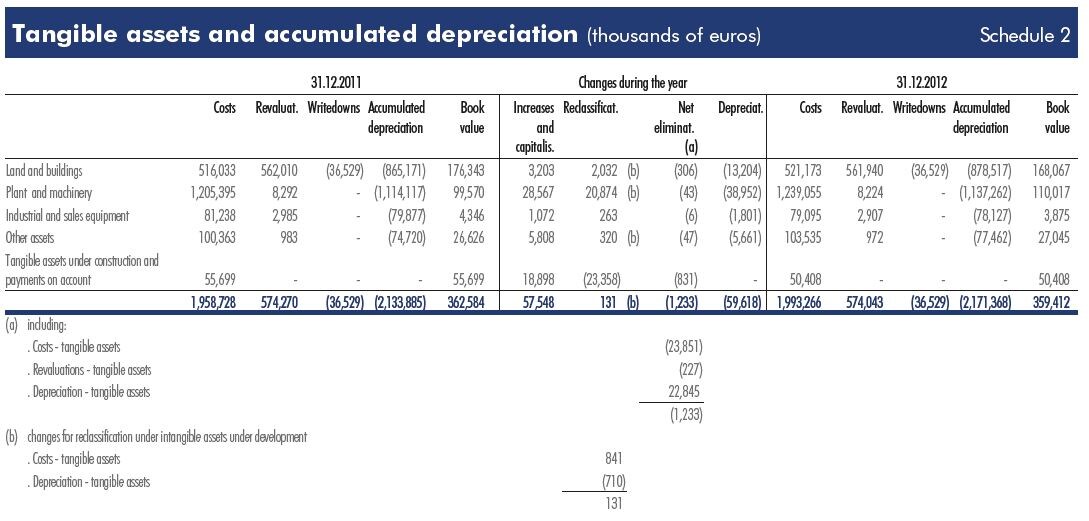
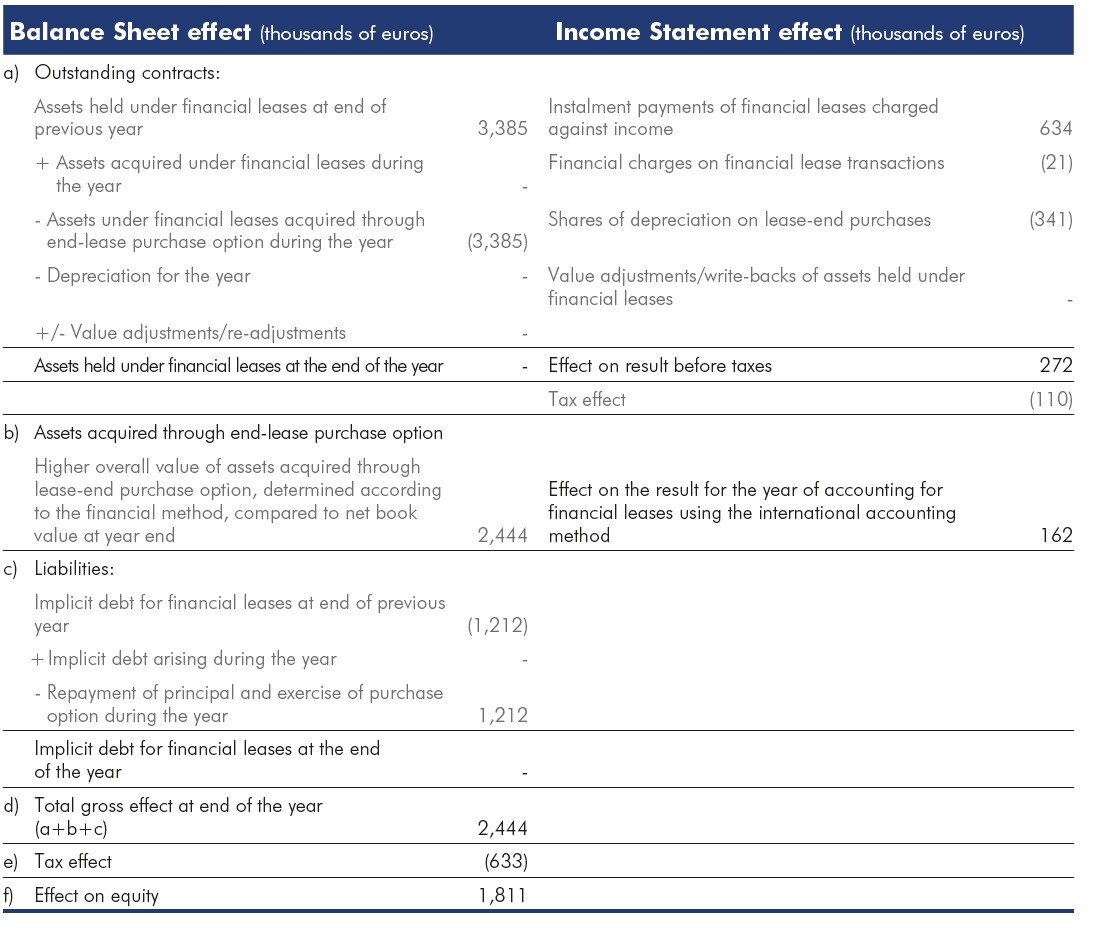
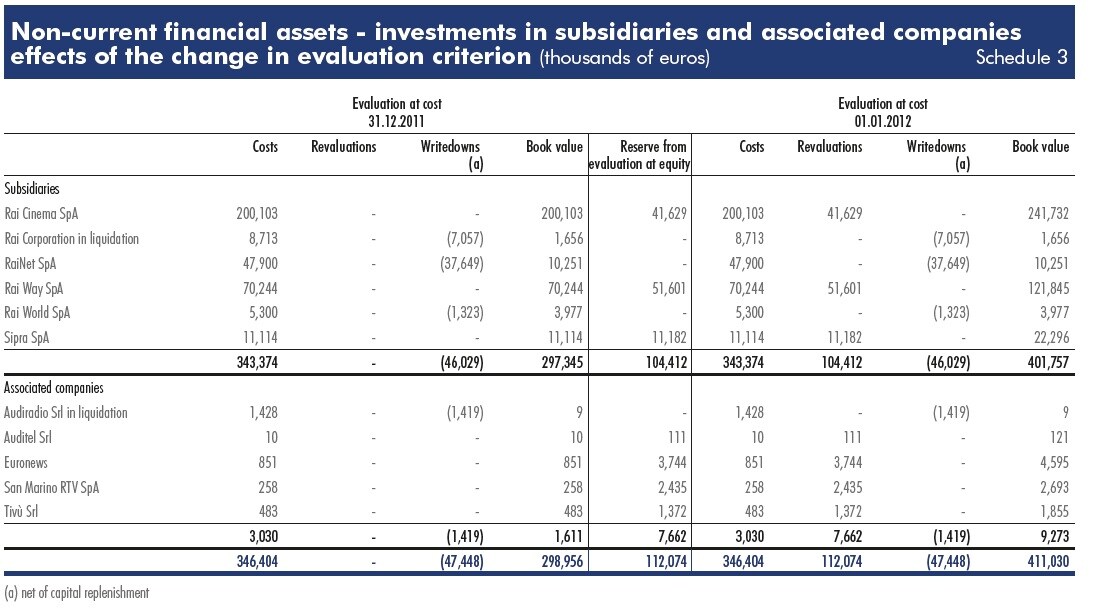
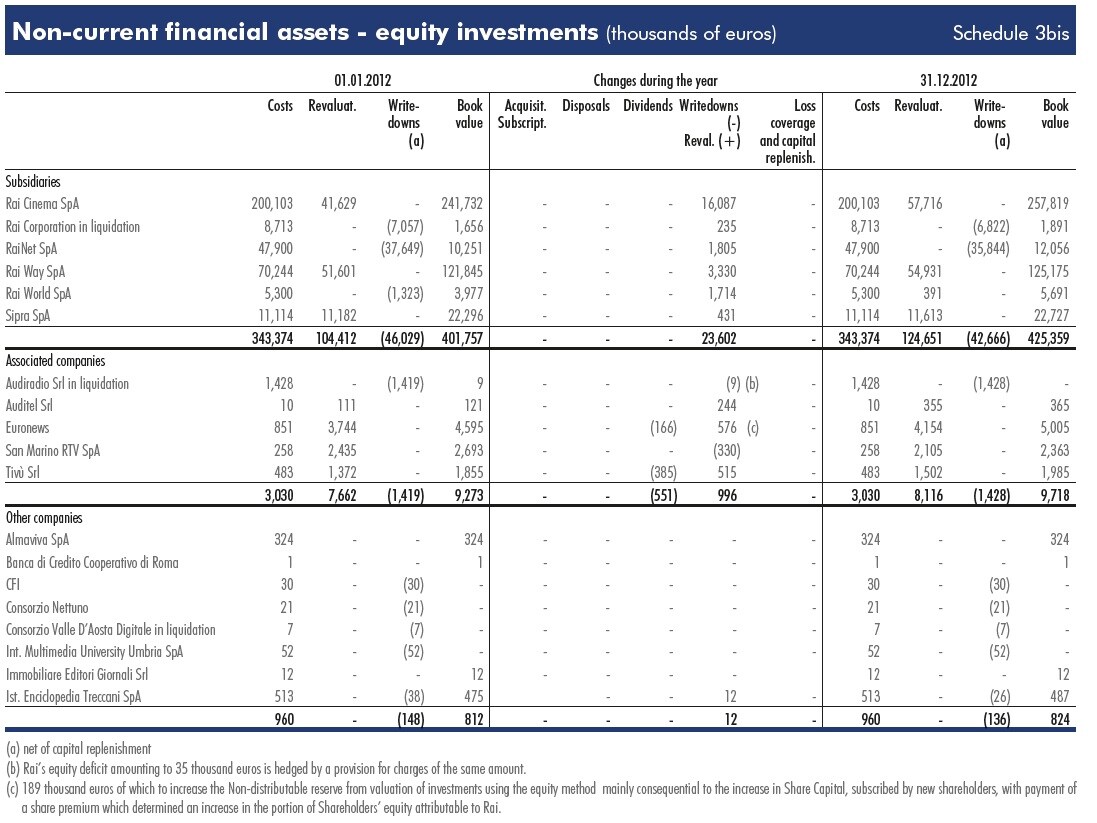
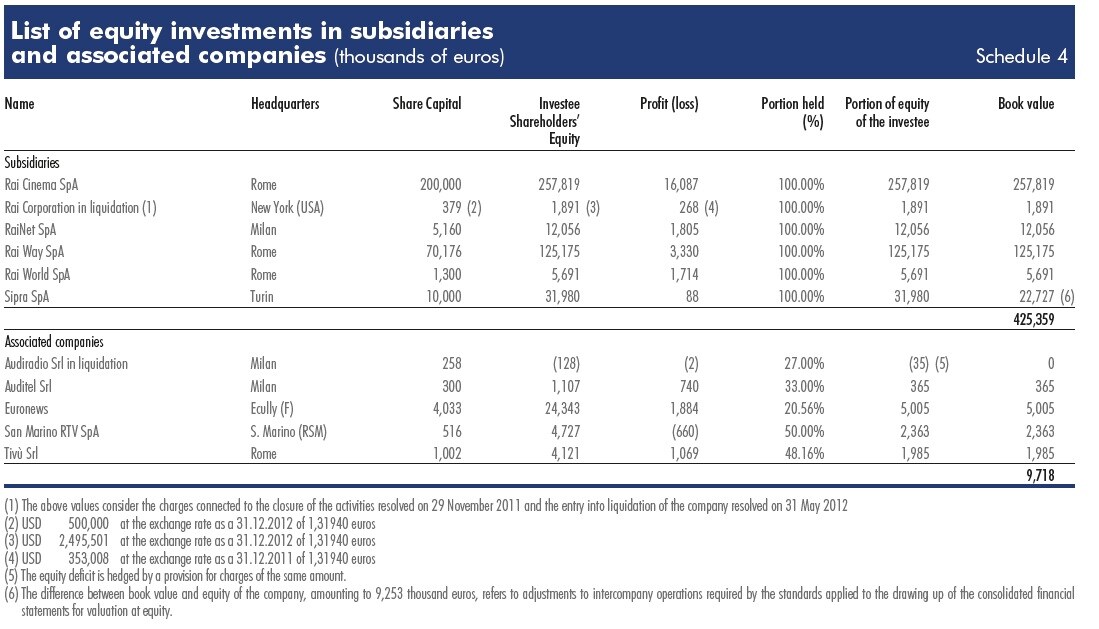
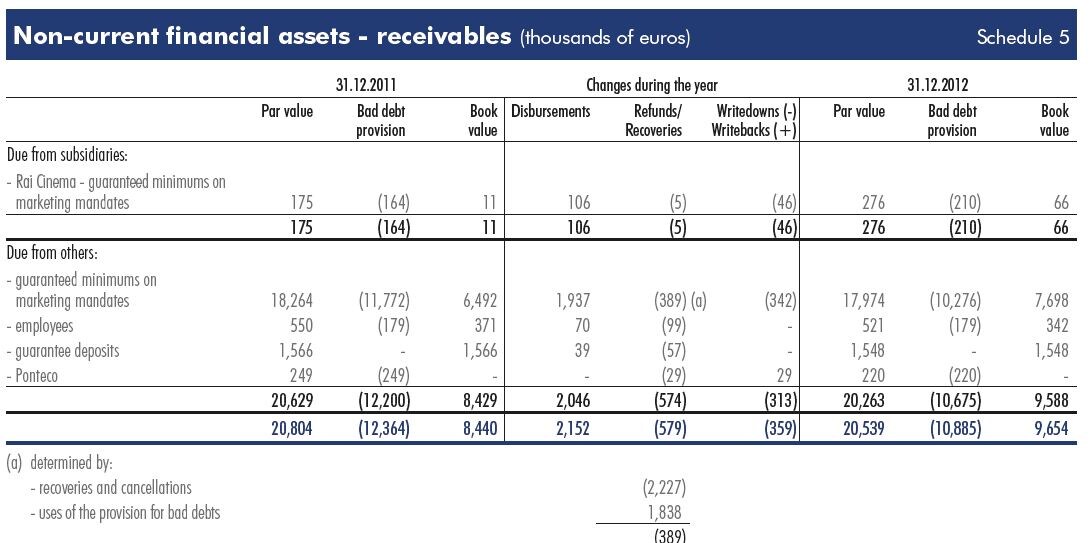

Current assets
Inventories
Inventories amount to 1,653 thousand euros net of the writedown provision (at 31 December 2011: 1,366 thousand euros).
As shown in Schedule 7, they comprise:
• Raw materials, supplies and consumables: these amount to 611 thousand euros net of the inventory provision for 13,266
thousand euros. They consist entirely of supplies and spare parts for maintenance and the operation of equipment, considered
as consumables since they are not directly incorporated into products.
• Finished products and merchandise: these consist of inventories associated with the book and periodicals publishing
business, amounting to 532 thousand euros net of a writedown of 686 thousand euros to bring them into line with their
estimated realisable value, and by inventories associated with the commercial activity, amounting to 510 thousand euros
net of a writedown of 216 thousand euros to bring them into line with their estimated realisable value.

Receivables
Receivables total 992,357 thousand euros, showing a decrease of 299,272 thousand Euros on 31 December 2011, as can
be seen in Schedule 8, which gives a breakdown of receivables, and in Schedules 9 and 11 which show their distribution by
maturity, type and by currency. Their distribution by geographic area is shown in Schedule 10.
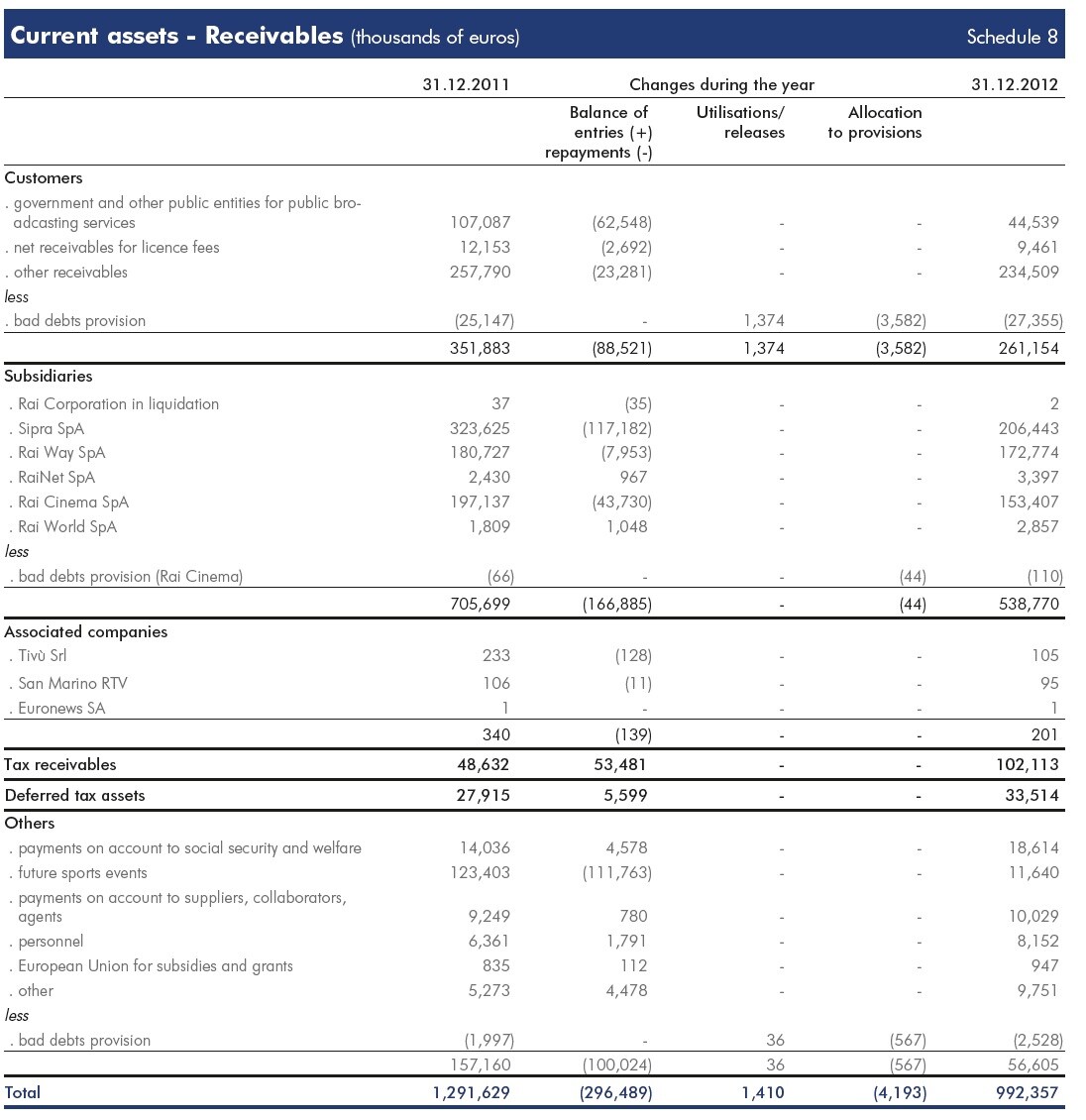
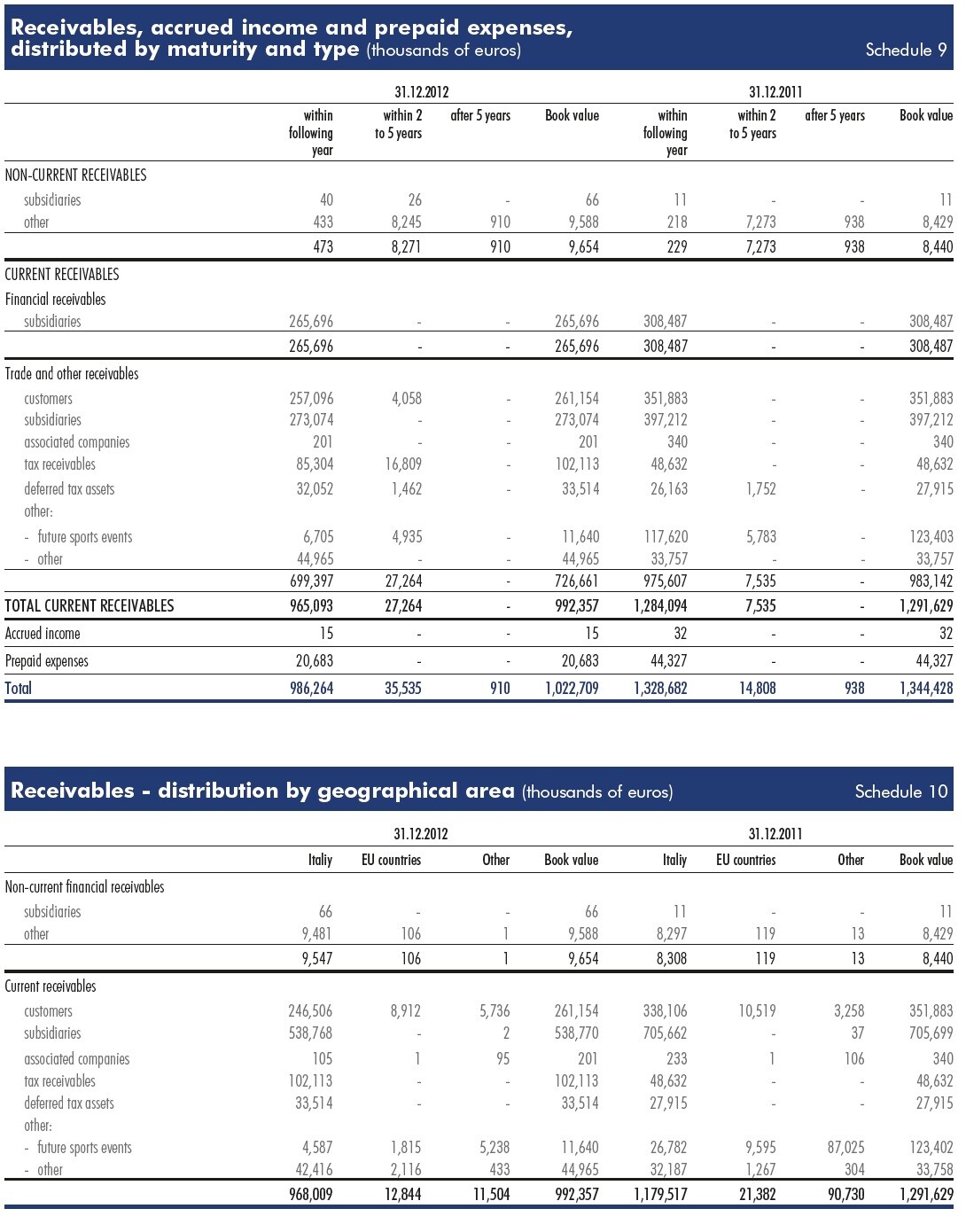
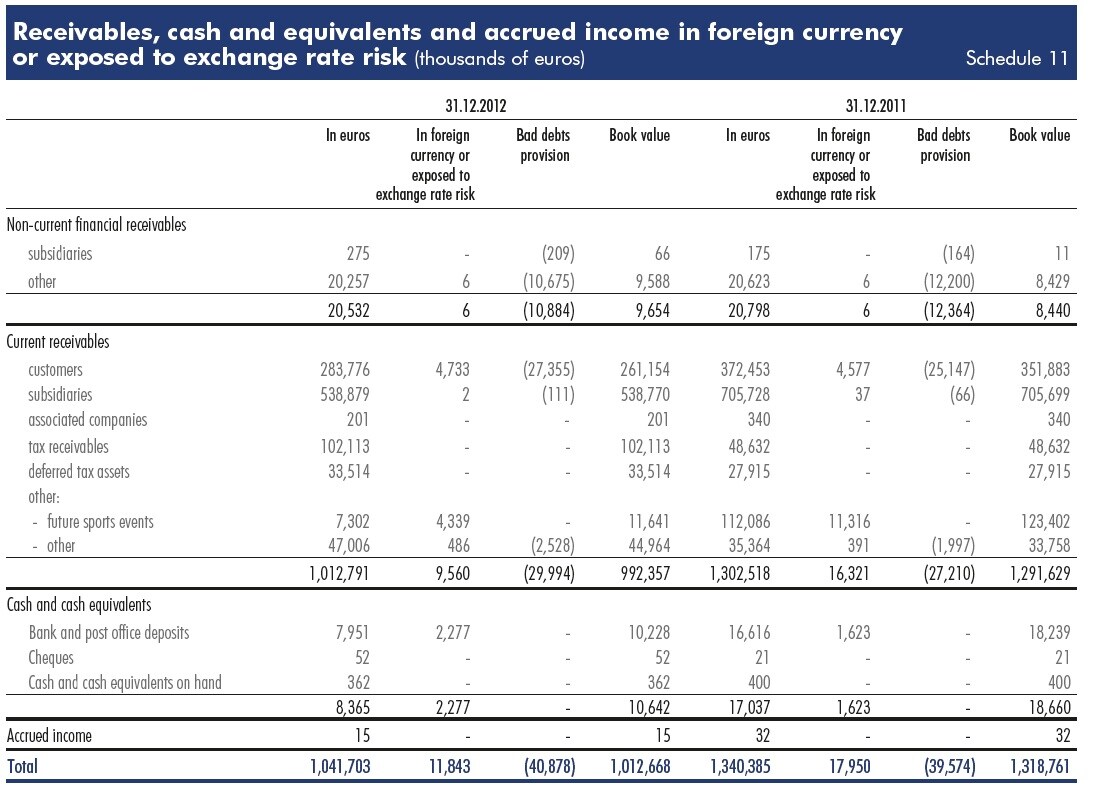
Receivables from customers: these relate to trade receivables, excluding those from subsidiaries and associated companies,
which are carried under separate headings. They total 261,154 thousand euros, with a nominal value of 288,509 thousand
euros which has been written down by 27,355 thousand euros to bring them to their estimated realisable value and compared
with 31 December 2011 they show a decrease of 90,729 thousand euros.
Details of the caption are divided into:
• Receivables for public broadcasting services to central government and other public entities: as shown in the following table,
these amount to a par value of 44,539 thousand euros, down 62,548 thousand euros on 31 December 2011, equivalent
to the balance between the increase in invoices issued and for amounts accrued for 2012 less collections.
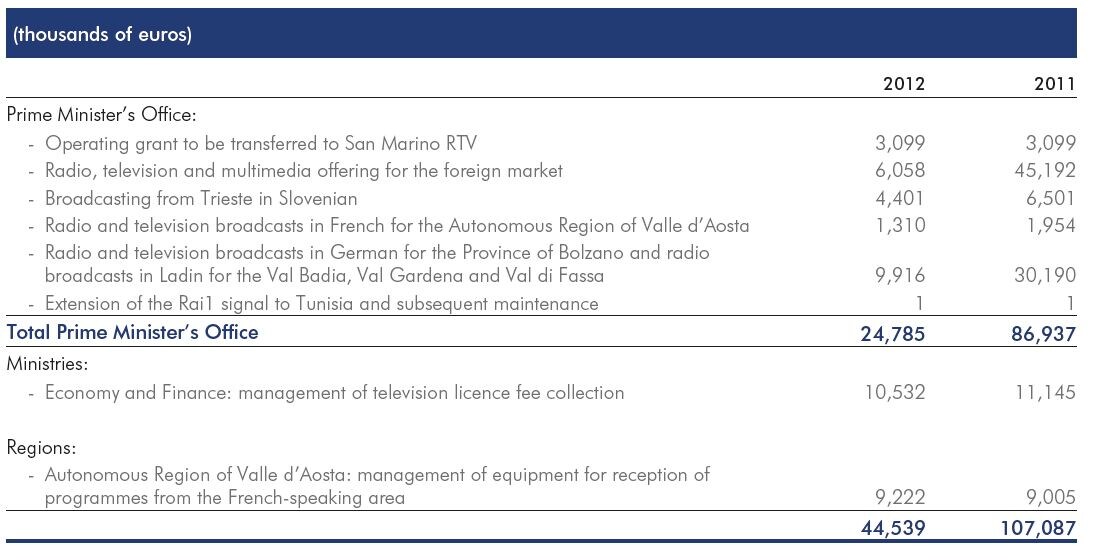
The following should be noted in connection with the above receivables:
– Prime Minister’s Office: receivables for television, radio and multimedia offering for broadcasting abroad refer to services
rendered in 2012; receivables for broadcasts in Slovenian relate to services rendered in 2011, amounting to 137 thousand
euros, and in 2012 to 4,264 thousand euros, while receivables for broadcasts in French, German and Ladin relate
to services rendered in 2012;
– Ministry of the Economy and Finance: in relation to the management of television licence fee collection, the receivable
refers only to 2012;
– Autonomous Region of Valle d’Aosta:the receivable of 9,222 thousand euros relates to the reimbursement of costs
incurred for the operation of equipment for the reception of French-language programmes for the years from 1994 to
2012.
• Net receivables for licence fees: these amount to 9,461 thousand euros, down 2,692 thousand euros on 31 December
2011, representing licence fees not yet transferred to Rai. Activities, already successfully pursued in the previous year, will
be launched to recover such receivables. They consist in asking the Ministry of the Economy and Finance to increase the
specific provision of the expense section during the settlement of the Government Financial Statements for 2013, in order
to allow recovery, with liquidation of the fourth instalment of transfer of the fees, envisaged to take place in December
2013.
• Other receivables: these amount to a par value of 234,509 thousand euros, down 23,281 thousand euros on 31
December 2011. They relate to the sale of rights and to services of varying nature.
Receivables from subsidiaries: disclosed at a par value of 538,770 thousand euros (705,699 thousand euros at 31
December 2011) net of a provision for bad debts of 110 thousand euros, set-up against the risk of recoverability of costs
sustained in relation to commercial initiatives. They represent the year-end balance of transactions with subsidiaries, as shown
in Schedule 8. They include financial receivables of 265,696 thousand euros (308,487 thousand euros at December 2011)
2,164 thousand euros of which unavailable due to restriction by attachment and other receivables amounting to 273,074
thousand euros (at 31 December 2011: 397,212 thousand euros).
Receivables from associated companies: these amount to 201 thousand euros (340 thousand euros at 31 December
2011) and represent the balance of non-financial transactions with Tivù (105 thousand euros), San Marino Rtv (95 thousand
euros) and Euronews (1 thousand euros).
Tax receivables: these are carried at nominal value of 102,113 thousand euros (48,632 thousand euros at 31 December
2011). They comprise 74,381 thousand euros for the balance of Group VAT credits for tax refunds requested pursuant to
article 2 paragraph 1 quater Decree Law 201/2011 for IRES relating to the company and to the subsidiaries that adhered
to the tax consolidation arrangement, deriving from the deductibility of IRAP relating to personnel costs and similar (16,809
thousand euros), and other tax reimbursements requested (7,022 thousand euros), for IRAP paid on account exceeding the
amount accrued (3,791 thousand euros) with the remainder consisting of minority captions.
Deferred tax assets: these amount to 33,514 thousand euros and represent the credit deriving from items deductible on a
deferred basis for tax purposes, as explained more fully in the section dealing with income taxes.
Details of deferred tax assets, regarding movements in 2012, are provided in the following table:
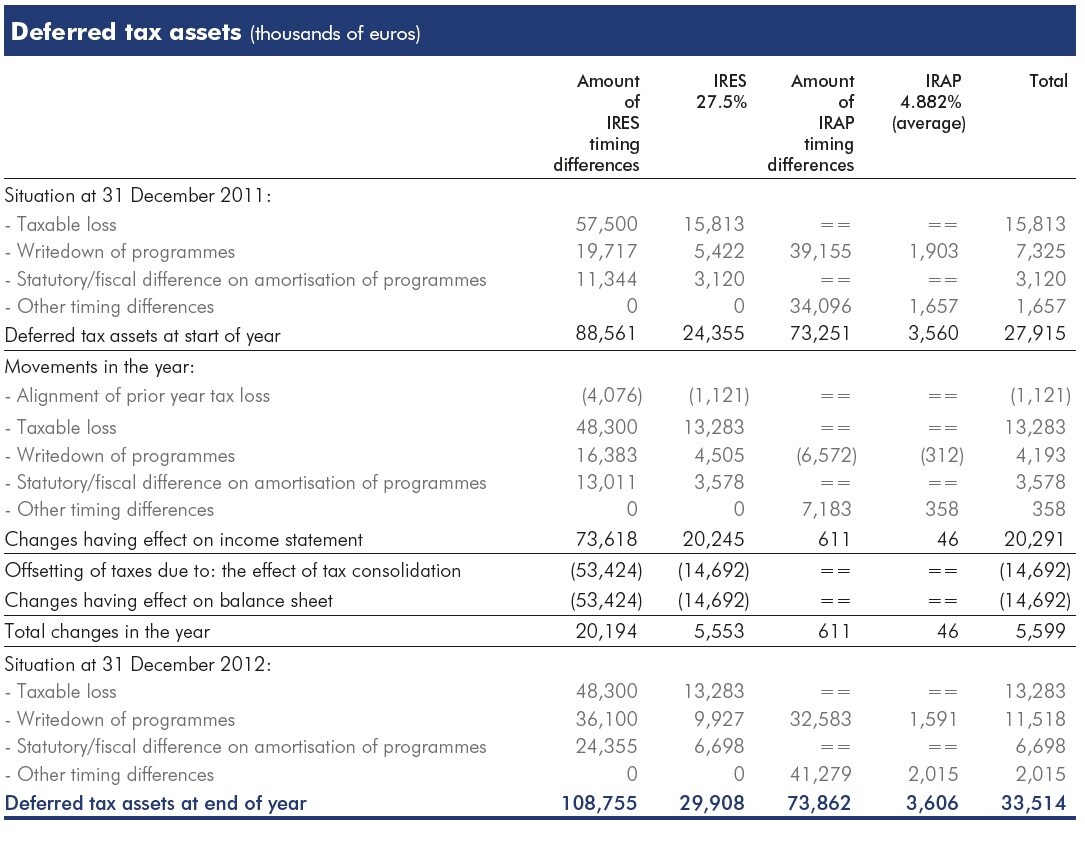
Receivables from others: these amount to 56,605 thousand euros (157,160 thousand euros at 31 December 2011). Net
of writedowns of 2,528 thousand euros, they reflect the value of other types of receivable as described below:
• advances to Social Security institutions on contributions payable for artistic activities, carried at nominal value of 18,614
thousand euros;
• advances to suppliers on sports events filming rights, carried at a par value of 11,640 thousand euros;
• miscellaneous advances to suppliers carried at a par value of 10,029 thousand euros;
• receivables from personnel carried at a par value of 8,152 thousand euros. These are composed mainly of receivables for
labour disputes (2,140 thousand euros), payments in advance for travel expenses (2,196 thousand euros) and payments
in advance for production expenses (1,779 thousand euros);
• receivables from the European Union for subsidies and grants subsidies and grants for a par value of 947 thousand euros, consisting entirely
of receivables for research projects;
• receivables from others, carried at a par value of 9,751 thousand euros..
Cash and cash equivalents
These are listed in Schedule 12, and comprise:
• Bank and post office deposits: these amount to 10,228 thousand euros (18,239 thousand euros at 31 December 2011).
They represent sight or short-term balances on deposit or current account with banks, financial institutions and the Post
Office.
• Cheques: these amount to 52 thousand euros (21 thousand euros at 31 December 2011).
• Cash and cash equivalents on hand: these amount to 362 thousand euros (400 thousand euros at 31 December 2011)
and include liquid funds in the form of cash and equivalent instruments (duty stamps, cashier’s cheques or bank-guaranteed
cheques etc) held by the Company at 31 December 2012.
Schedule 11 gives a breakdown of the caption by euros and other currencies, while Schedule 24 shows amounts at banks and
the Post Office restricted by attachments.

Accrued income and prepaid expenses
Accrued income and prepaid expenses total 20,698 thousand euros. They are detailed in Schedule 13.
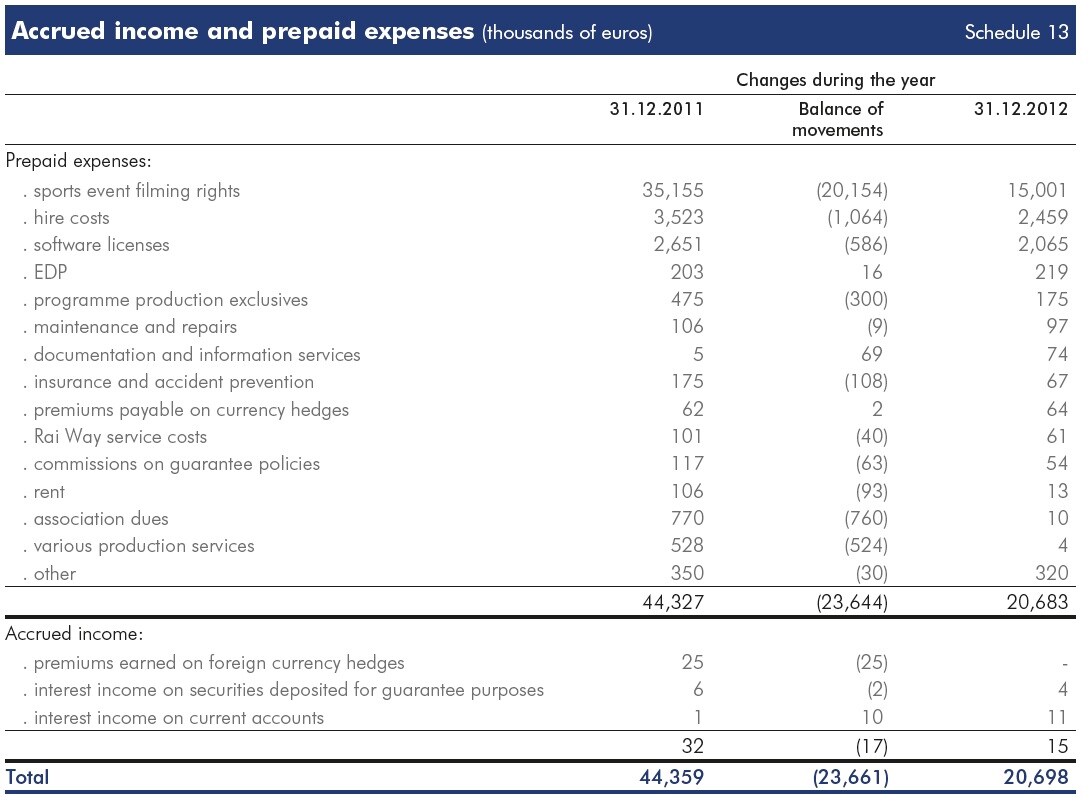
Liabilities
Shareholders’ equity
Shareholders’ equity totals 294,148 thousand euros.
The components of Shareholders’ equity and the effects of operations carried out in 2012 and the previous year are shown
in Schedule 14.
Schedule 15 presents the classification of the Shareholders’ equity items in compliance with their origin, possibility of use and
distribution, as well as their use during the previous three years.
The notes indicated hereunder provide further details on the contents of the individual items.
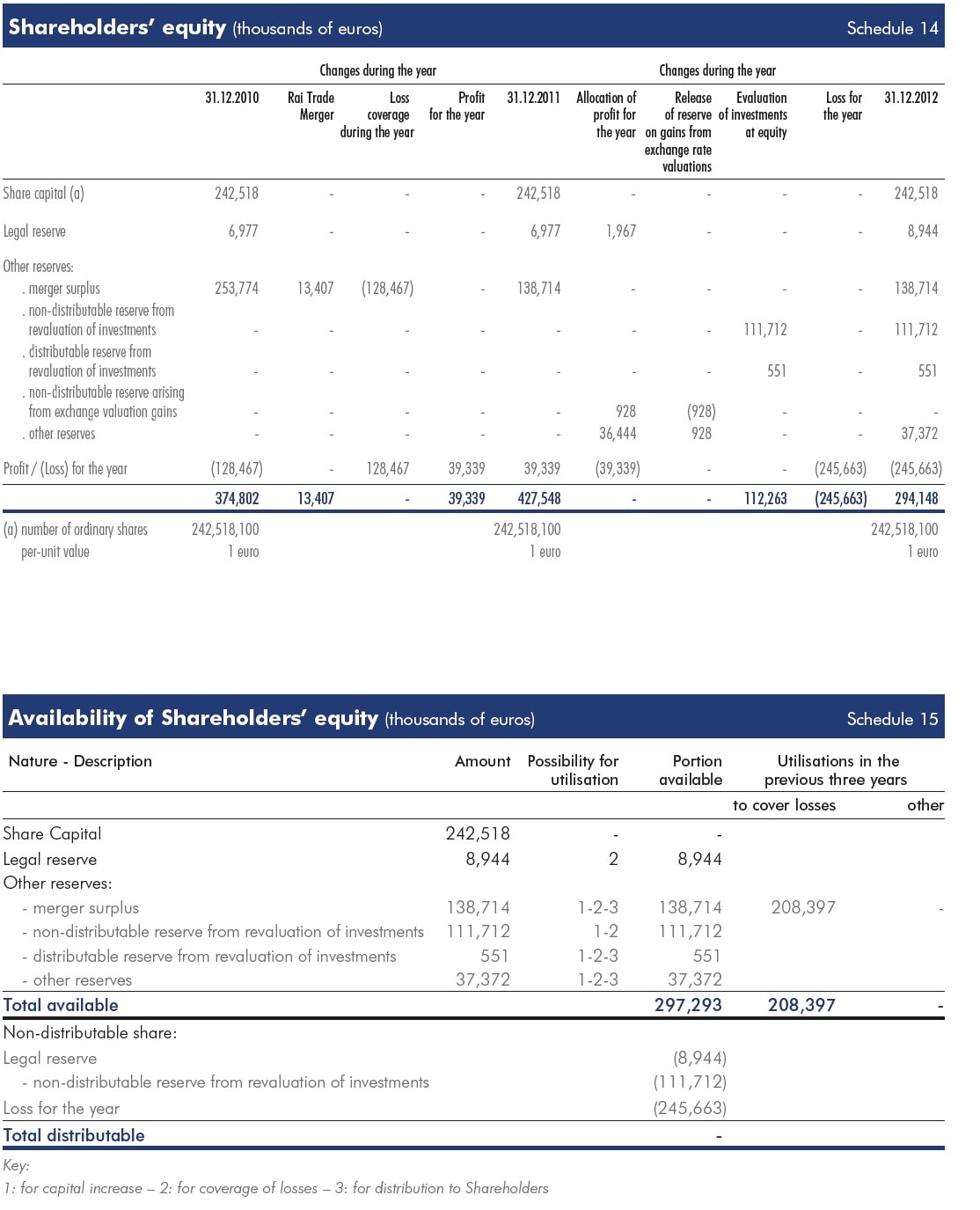
Share Capital
At 31 December 2012 the share capital was represented by 242,518,100 ordinary shares with a par value of 1 euro each,
owned by the Ministry of the Economy and Finance (241,447,000 shares, equal to 99.5583% of the share capital) and SIAE,
the Italian Association of Authors and Publishers (1,071,100 shares, equal to 0.4417% of the share capital).
Legal Reserve
The legal reserve amounts to 8,944 thousand euros.
Other reserves
These total 288,349 thousand euros and are comprised as follows:
• merger surplus: 138,714 thousand euros;
• revaluation of equity investments: 112,263 thousand euros, 111,712 thousand of which are not available for distribution;
• other: 37,372 thousand euros.
Loss for the year
This amounts to 245,662,838.10 euros.
Provisions for risks and charges
These amount to 466,446 thousand euros, up 78,479 thousand euros net on 31 December 2011. The breakdown of these
items and details of the aforementioned reduction are shown in Schedule 16. The notes which follow provide additional information
on the individual provisions.
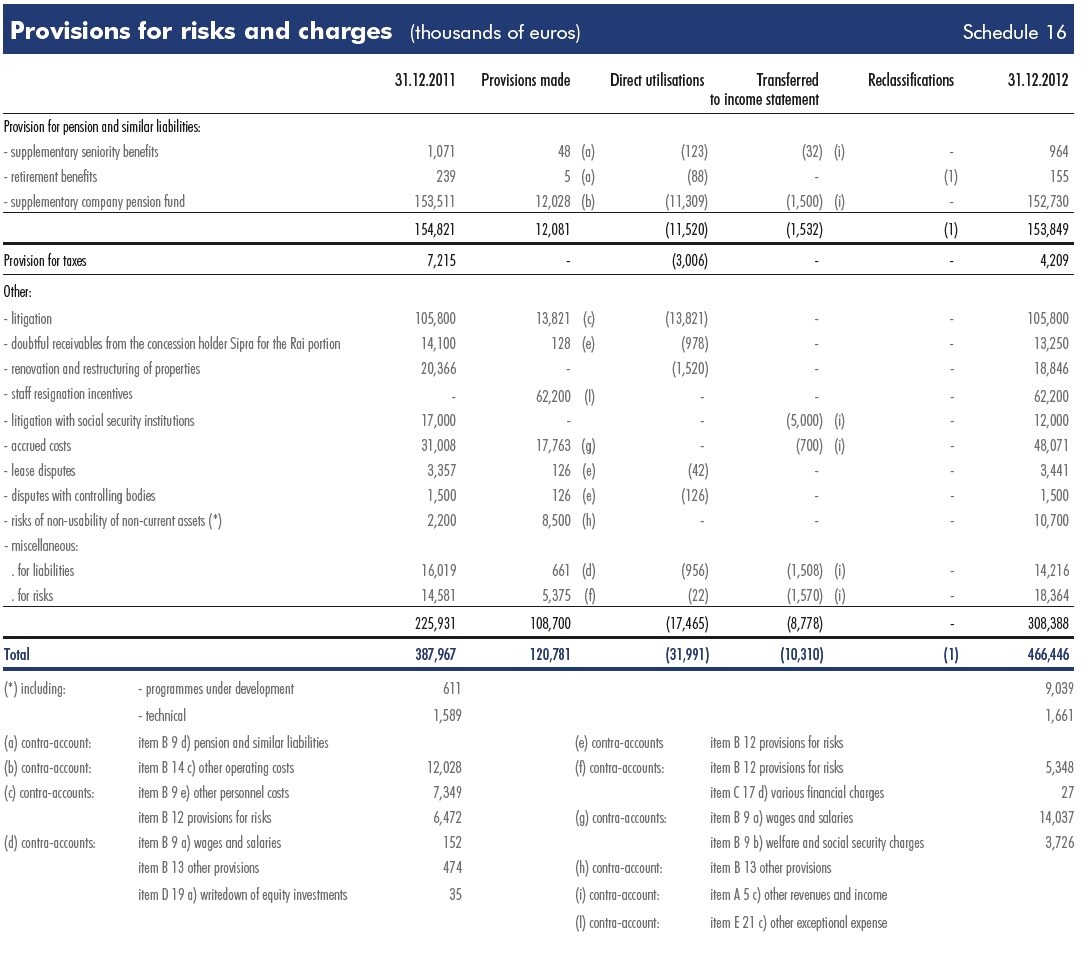
Provision for pension and similar liabilities: this amounts to 153,849 thousand euros and comprises the supplementary
seniority benefits provision, the retirement benefits provision and the company supplementary pension fund.
• The provision for supplementary seniority benefits amounts to 964 thousand euros (1,071 thousand euros at 31 December
2011). It represents the liability in respect of indemnities in lieu of notice towards employees hired before 1978 who have
reached the compulsory retirement age. The amount is revalued each year for consumer price inflation. In the event of
early termination of employment, or changes in category, the amounts accrued are released.
• The provision for retirement benefits amounts to 155 thousand euros (239 thousand euros at 31 December 2011) and
includes amounts accrued until 31 December 1988 and the revaluations of these amounts allocated in subsequent periods
in order to protect the real value of the provision for eligible employees in accordance with the terms of the national
collective labour agreement.
Since 1 January 1989 retirement benefits paid by Rai and withholdings from employees have been paid into the CRAIPI
(supplementary retirement fund for Rai employees) and the FIPDRAI (supplementary retirement fund for Rai managers),
associations which are responsible for managing retirement funds under the agreements entered into between Rai and the
trade unions.
Following the agreement entered into on 25 October 2001, the provision for retirement benefits for non-executive staff was
completely liquidated (with disbursement to employees or to the CRAIPI). For executive staff, upon retirement, the funds accumulated
by Rai, CRAIPI and FIPDRAI are paid out unless employees opt, at the time they obtain the pension rights, to obtain
equivalent life annuities. In this case, the Rai and FIPDRAI funds remain with the associations to finance the said life annuities.
• The provision for supplementary seniority benefits amounts to 152,730 thousand euros (153,511 thousand euros at 31
December 2011) and includes:
– 145,297 thousand euros for supplementary pension benefits currently being paid (144,578 thousand euros at 31 December
2011). It consists of funds accrued for employees who have opted for the supplementary pension plan under the
trade union agreements, which are kept at an adequate level to ensure said benefits, with respect to actuarial reserves.
– 7,433 thousand euros (8,933 thousand euros at 31 December 2011) for supplementary pensions that will be paid to
eligible executive staff still in service in the event that they opt for the supplementary pension plan with the envisaged term.
The downsizing of the fund compared to the previous year is due to the cancellation of the previous agreement entered
into on 29 January 2013. On the basis of said agreement, the option available only regards executives over the age
of 60 and must be exercised within three months of said cancellation, with departure from the company. The charge is
determined, only for those employees implicated, with reference to pay earned, seniority and financial and demographic
parameters normally used in similar cases.
For taxes: these amount to 4,209 thousand euros (7,215 thousand euros at 31 December 2011). The following table shows
a breakdown of the item and changes during 2012.
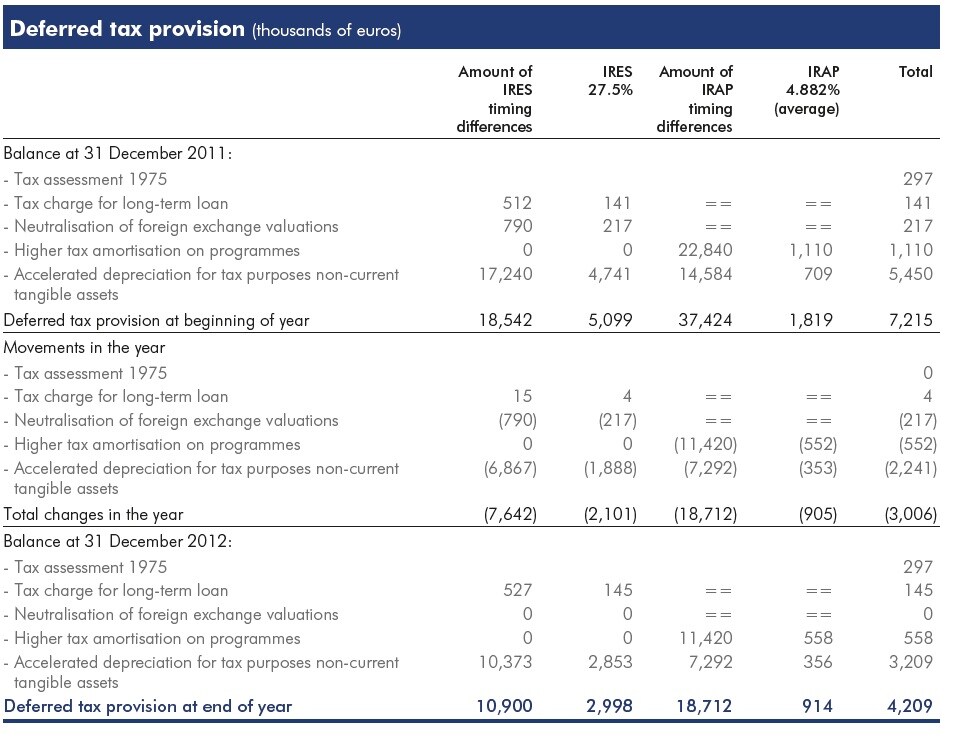
Other provisions: these amount to 308,388 thousand euros (225,931 thousand euros at 31 December 2011). They include
provisions for costs or losses, the existence of which is certain but the amount of which cannot be exactly determined, or which
are probable and the amount of which can be reasonably estimated. The main items are detailed in Schedule 16. As regards
pending litigation with employees and third parties, the amount carried in the provisions for risks and charges is the best estimate
of the likely charges based on the most up-to-date information available.
Provision for staff severance pay


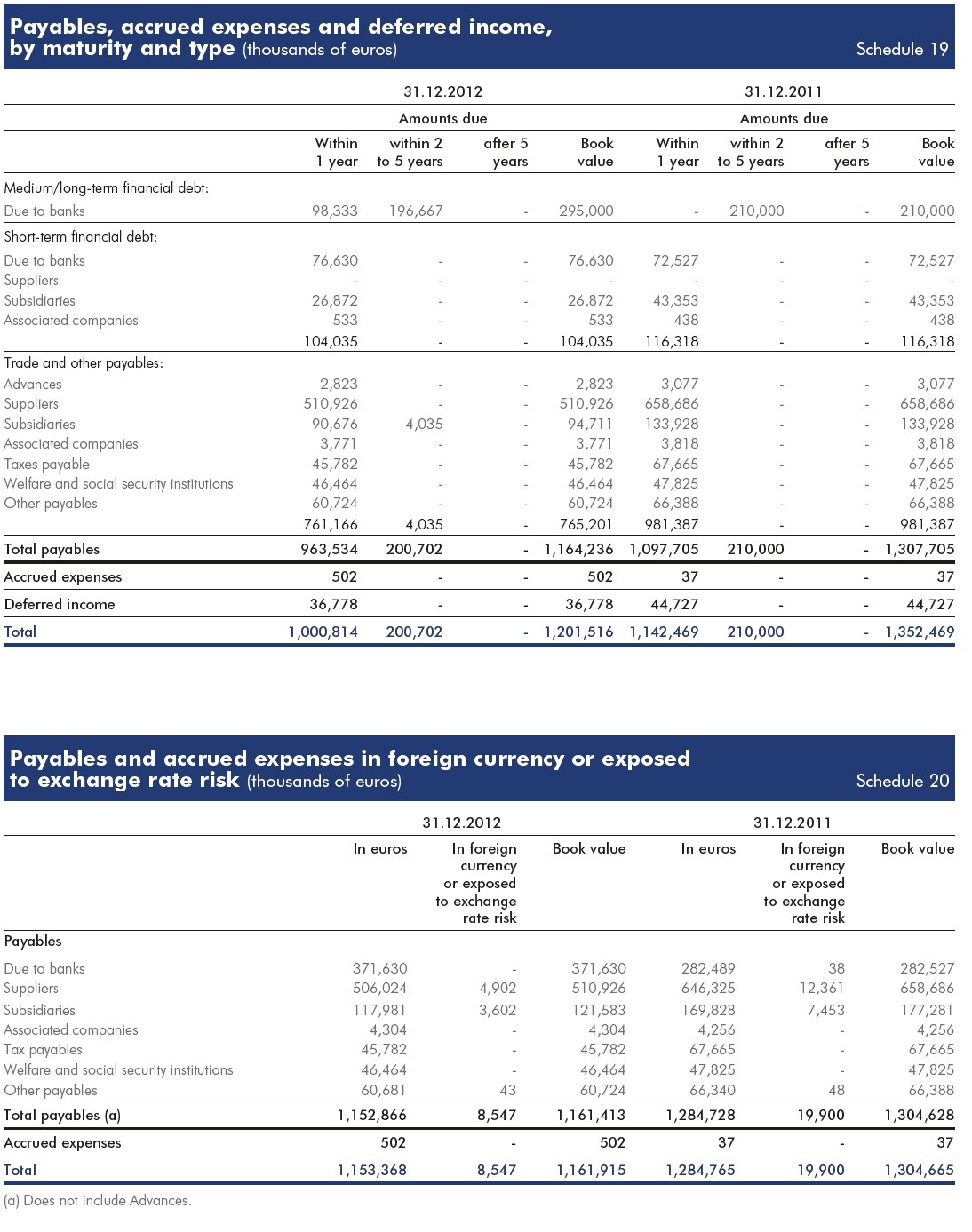

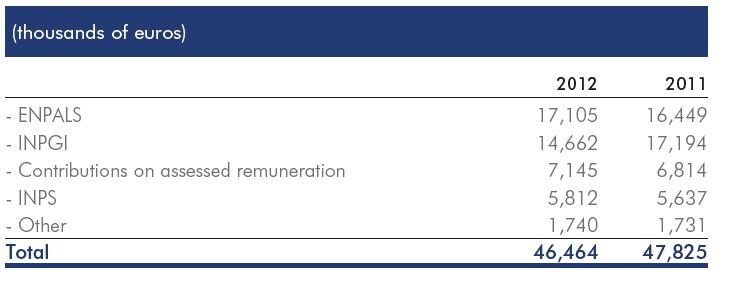

Accrued expenses and deferred income
This caption totals 37,280 thousand euros. Details and a comparison with the previous year are provided in Schedule 21.
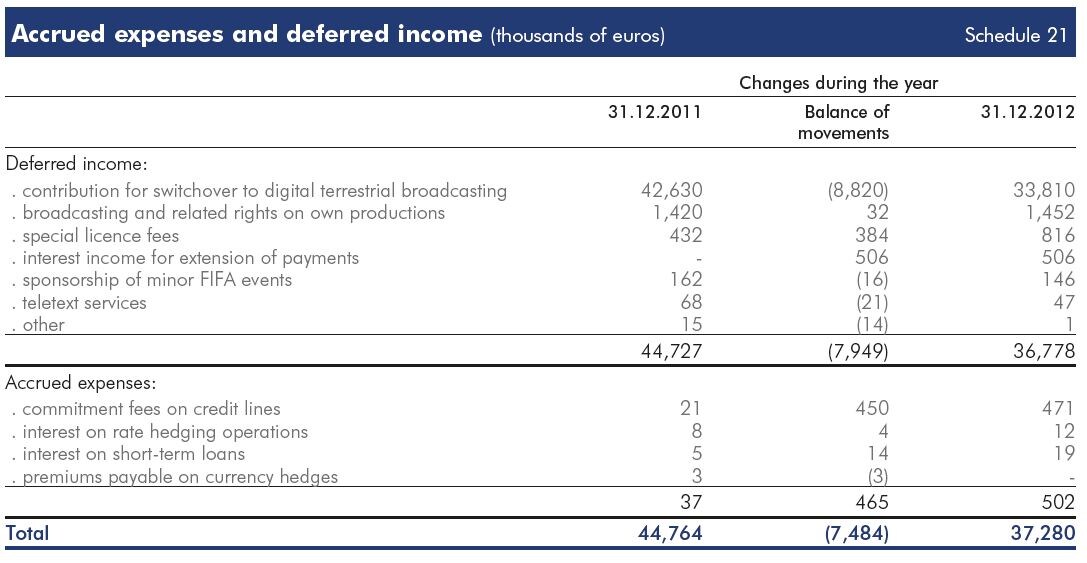
The caption contains the entire amount contributed of 33,810 thousand euros, net of the amount already booked to the income
statement, disbursed by the Ministry for Communications from 2007 to 2011 in support of initiatives to accelerate the
switch-over to the digital terrestrial platform, consisting of operations on systems and adaptation of the site infrastructures to
extend areas covered by the digital signal and improve reception and the quality of service perceived by the user.
The task of making the necessary investments is entrusted to the subsidiary Rai Way SpA, which is also responsible for the
design, installation, construction, maintenance, implementation, development and operation of the telecommunications networks.
The contribution is disclosed in the income statement of each year in relation to amortisation booked by the subsidiary, taking
into account the relationship between the amount of contributions collected and the investments necessary for the accomplishment
of related projects.
5) Memorandum accounts
Memorandum accounts amount to 298,554 thousand euros. A breakdown by type is provided in the table attached to the
Parent Company Balance Sheet.
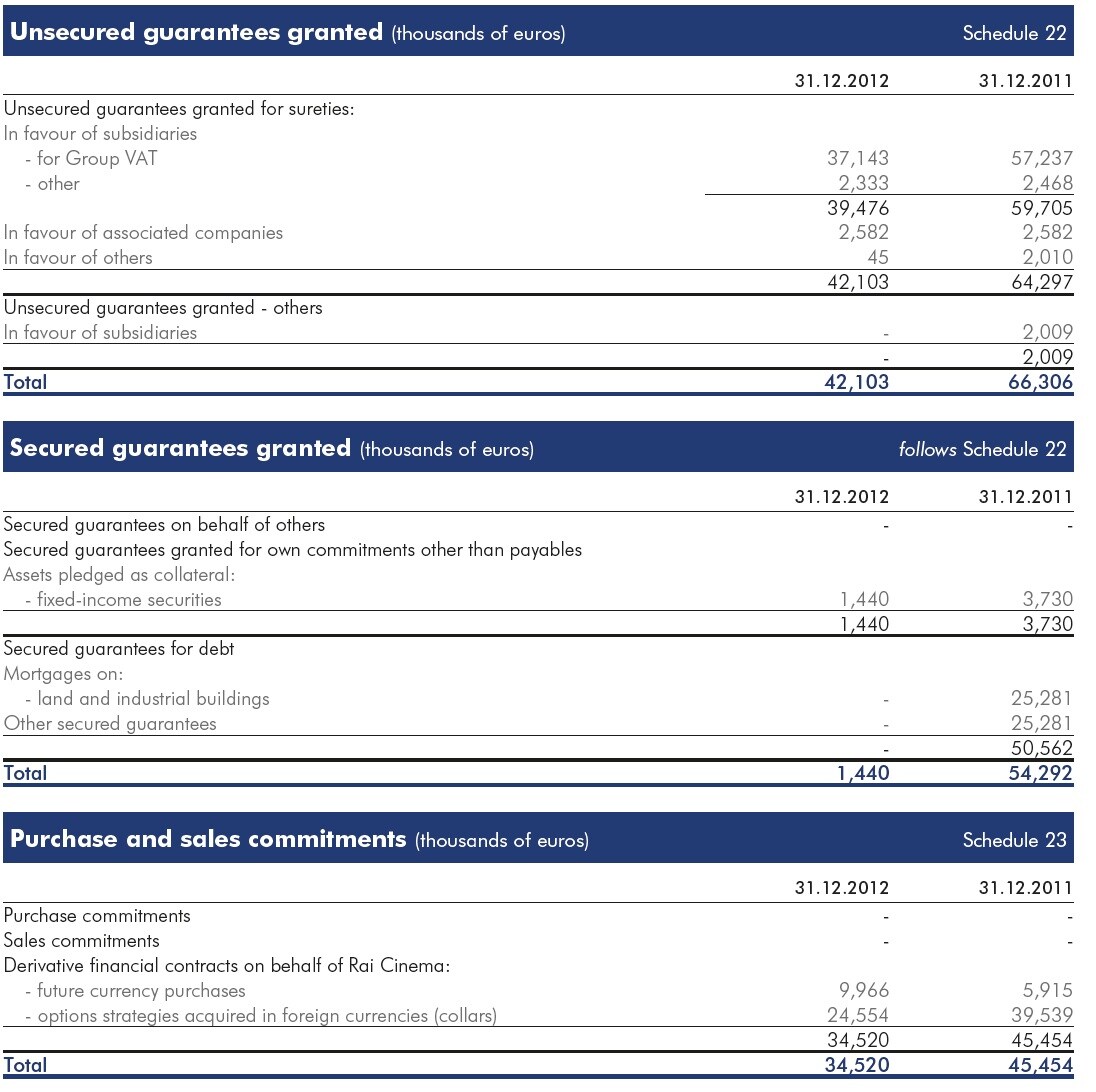
The terms of the hedge contracts covering the specific company commitments or those taken on for the subsidiary Rai Cinema
SpA relating to fair value are summarised in Schedule 25. The fair value of these instruments is determined with reference to
the market value on the closing date of the period under assessment; in the case of unlisted instruments, fair value is determined
using commonly used financial evaluation techniques.
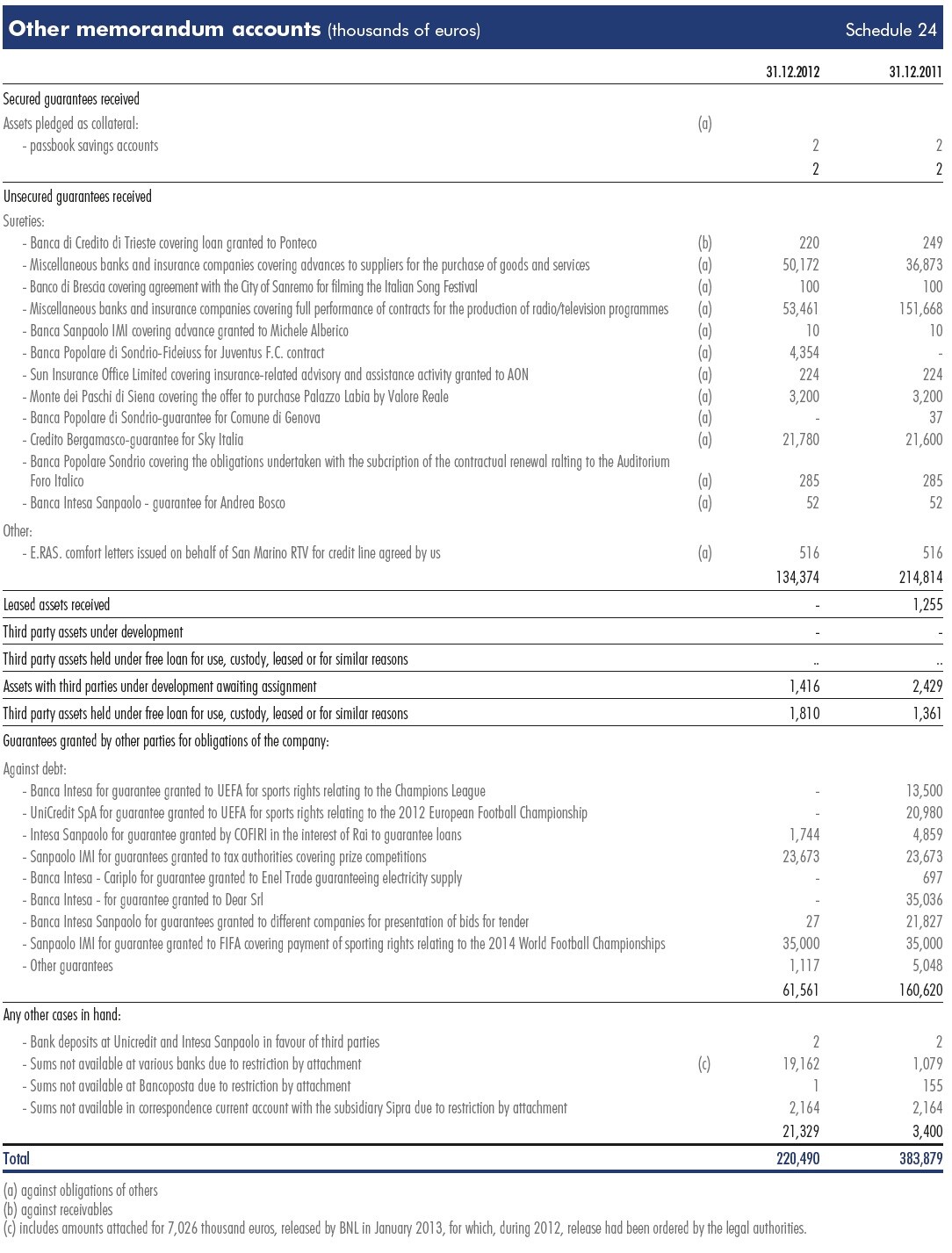
On the whole, hedging contracts entered into are, in observance of the Group policy, of a reasonable amount in relation to
the overall entity of the commitments subject to such risks.
At 31 December 2012 there were no commitments, other than those highlighted among the memorandum accounts, of
particular significance for the purchase or sale of goods and services in addition to those taken on in the normal course of
business that would require specific information to be given for a better understanding of the Company’s financial position.
Schedule 24 details the amount of company assets held by third parties for the various reasons indicated therein.
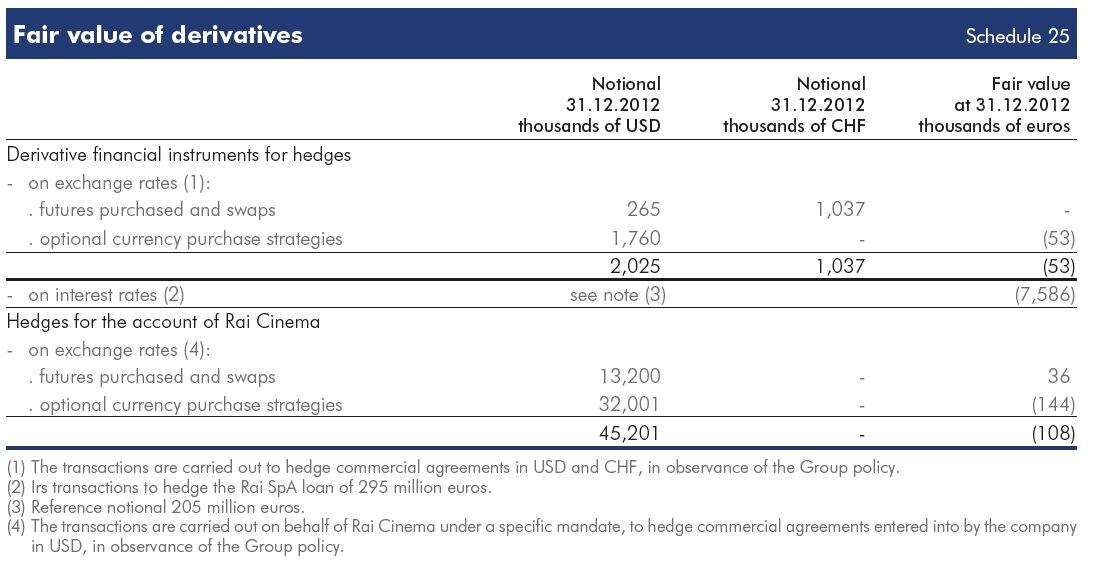
6) Income Statement
Production value
Revenues from sales and services:these amount to 2,550,013 thousand euros (2,751,712 thousand euros at 31 December
2011). They basically include revenues pertaining to the year from licence fees and advertising. A breakdown into major
components is given in Schedule 26. As can be seen from the distribution of revenues by geographic area, they almost all
originate in Italy.
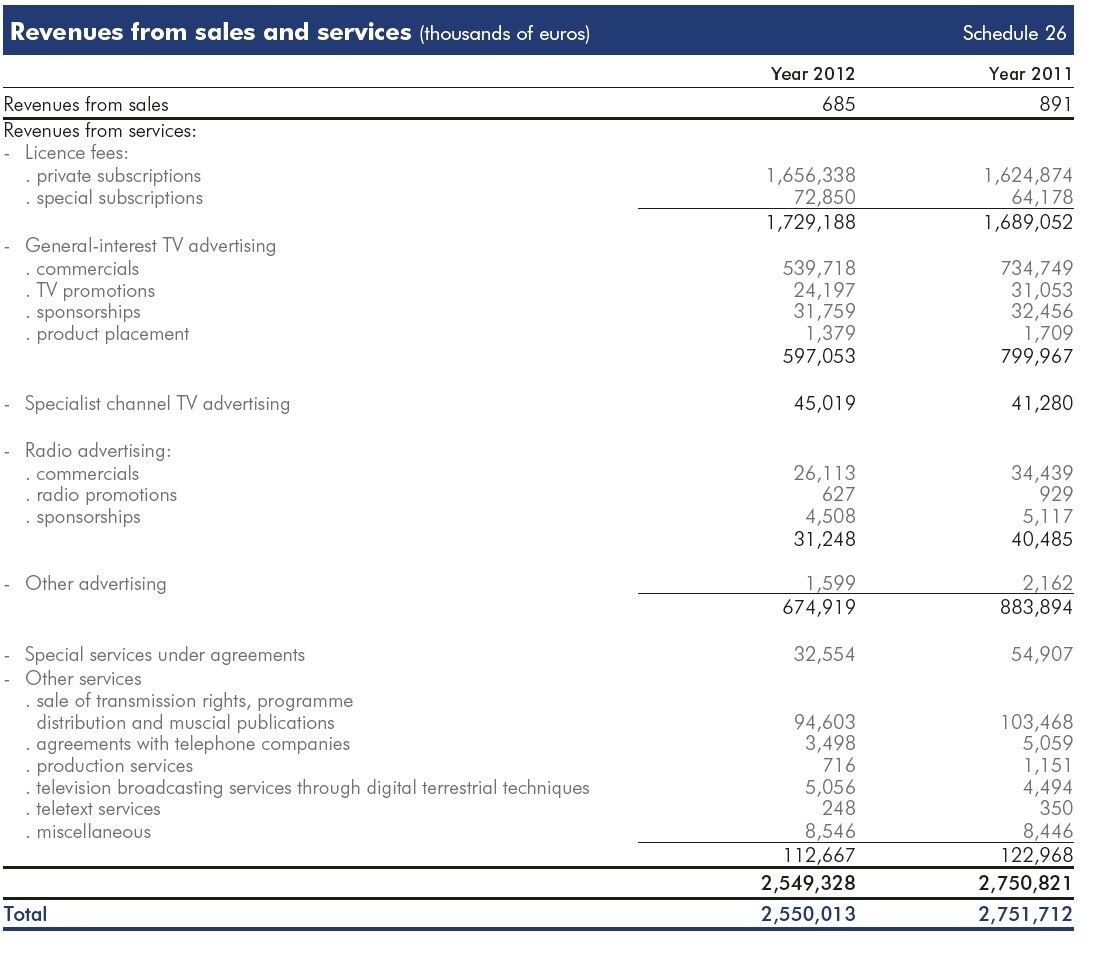
As regards revenues from licence fees, the mechanism used to determine the per-unit fee envisaged by the Consolidated
Broadcasting Law (“separate accounting”), aimed at guaranteeing the proportions between costs sustained by Rai, and certified
by an independent auditor, for the performance of its public service remit and resources from licence fees, highlights a
lack of the latter for the period from 2005 to 2011, totalling over 2 billion euros, of which more than 287 million euros refer
to 2011 alone. In 2011, Rai requested, issuing warnings to such effect, the payment of the sums owing to it, as highlighted
on the separate accounting forms, as well as interest matured and to mature.
For 2012, the “separate accounting” figures will be available, as established, within four months of the date on which the
Shareholders’ Meeting approves the financial statements.
Changes in inventories of work in progress, semi-finished and finished goods: the positive amount of 263 thousand
euros (up 55 thousand euros on 31 December 2011) expresses the increase in the value of inventories associated with the
commercial activity.
Changes in work contracts in progress: no value (9 thousand euros at 31 December 2011).
Internal cost capitalisations: the amount of 16,321 thousand euros (13,999 thousand euros at 31 December 2011): represents
internal costs associated with non-current assets, which were capitalised under the specific asset captions. Details are
shown in Schedule 27.

Other production-related income: these amount to 117,395 thousand euros (108,598 thousand euros at 31 December
2011) as detailed in Schedule 28.
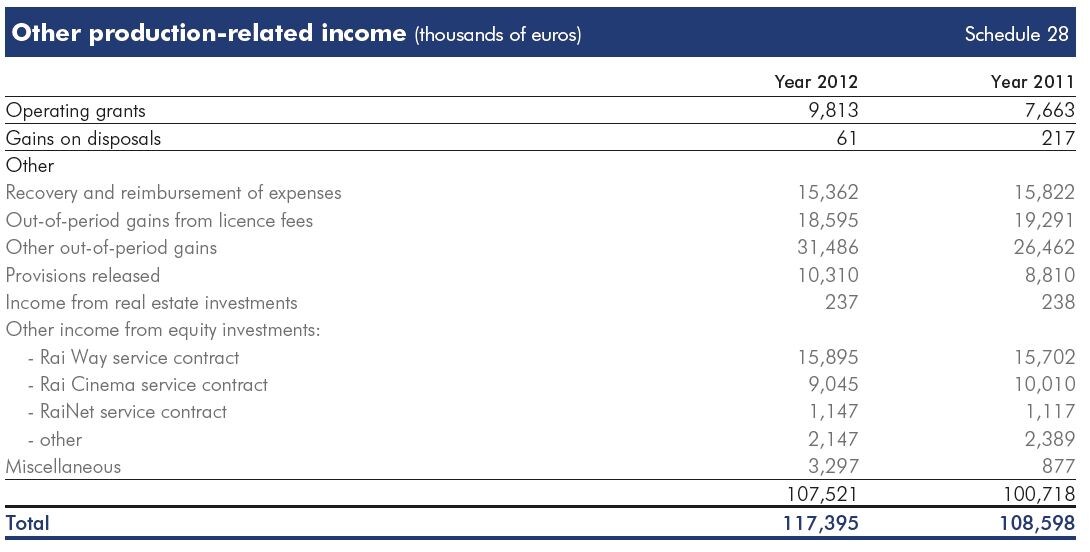
Production costs
This caption comprises costs and losses related to ordinary activities, excluding financial operations. The costs shown here
do not include those relating to non-current tangible and intangible assets, which are recorded under the respective asset
accounts.
Raw materials, supplies, consumables and merchandise: these total 22,932 thousand euros (22,607 thousand euros
at 31 December 2011), which includes purchases of technical materials for inventory – excluding items used in the construction
of plant, which are allocated directly to non-current tangible assets – production materials (sets, costumes etc.) and
miscellaneous operating materials (fuel, office supplies, printed documents etc.), net of discounts and allowances, as shown
in Schedule 29.

Services: these amount to 747,173 thousand euros (796,077 thousand euros at 31 December 2011) and comprise costs for
freelance workers and other external services, net of discounts and allowances, as shown in Schedule 30.

Among other things, they include emoluments, remuneration for special functions and reimbursement of expenses paid to
Directors for 1,592 thousand euros and to Statutory Auditors for 177 thousand euros.
They also include 153 thousand euros of fees for the statutory audit of the annual accounts by independent auditors, 23
thousand euros for other independent auditing services, and 17 thousand euros for other services.
Use of third-party assets: these amount to 758,871 thousand euros (683,584 thousand euros at 31 December 2011) and
express costs for rents, leases, usage rights and filming rights, as detailed in Schedule 31.
Production

Personnel : employee-related costs amount to 922,623 thousand euros (935,248 thousand euros at 31 December 2011),
broken down as indicated in the income statement. The average number of employees on the payroll in 2012 was 11,851, including
employees on fixed-term contracts (11,829 employees at 31 December 2011), distributed as detailed in Schedule 32.
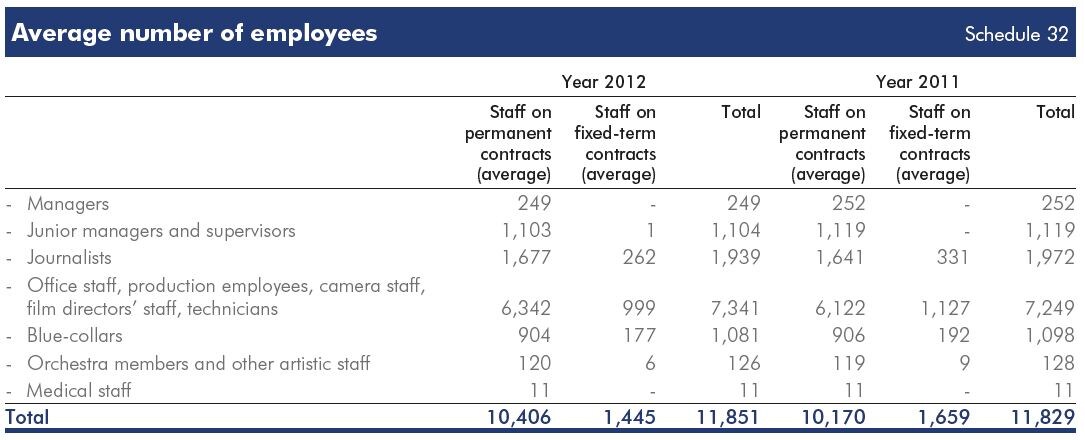
Amortisation, depreciation and writedowns:these amount to 330,874 thousand euros (356,604 thousand euros at 31
December 2011). The breakdown is shown directly in the income statement. In detail, amortisation in relation to intangible
assets refers basically to industrial patents and intellectual property rights for 232,602 thousand euros (255,224 thousand
euros at 31 December 2011), while Schedules 33 and 34 provide details of depreciation of tangible assets and writedowns
in relation to non-current assets. They include a writedown of capitalised programmes amounting to 21,847 thousand euros,
which was made to take account of the risk that certain programmes may not be transmitted, re-broadcast or commercially
exploited.
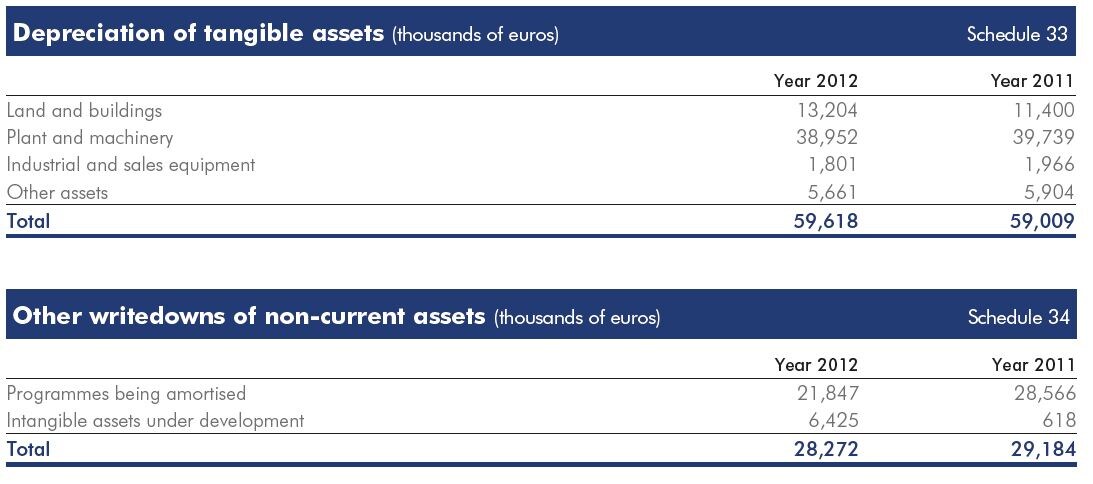
Changes in inventories of raw materials, supplies, consumables and merchandise: the amount of 24 thousand euros
(minus 60 thousand euros at 31 December 2011) represents the increase in net inventories carried under current assets at 31
December 2012 with respect to the previous year.
Provisions for risks: these amount to 12,200 thousand euros (9,561 thousand euros at 31 December 2011) and consist of
allocations to provisions for risks. The most significant items are detailed in Schedule 16.
Other provisions:these amount to 8,975 thousand euros (1,401 thousand euros at 31 December 2011). The main items
are shown in Schedule 16.
Other operating costs: these amount to 95,716 thousand euros (92,489 thousand euros at 31 December 2011). Their
composition is shown directly in the income statement and further information is provided in Schedule 35.
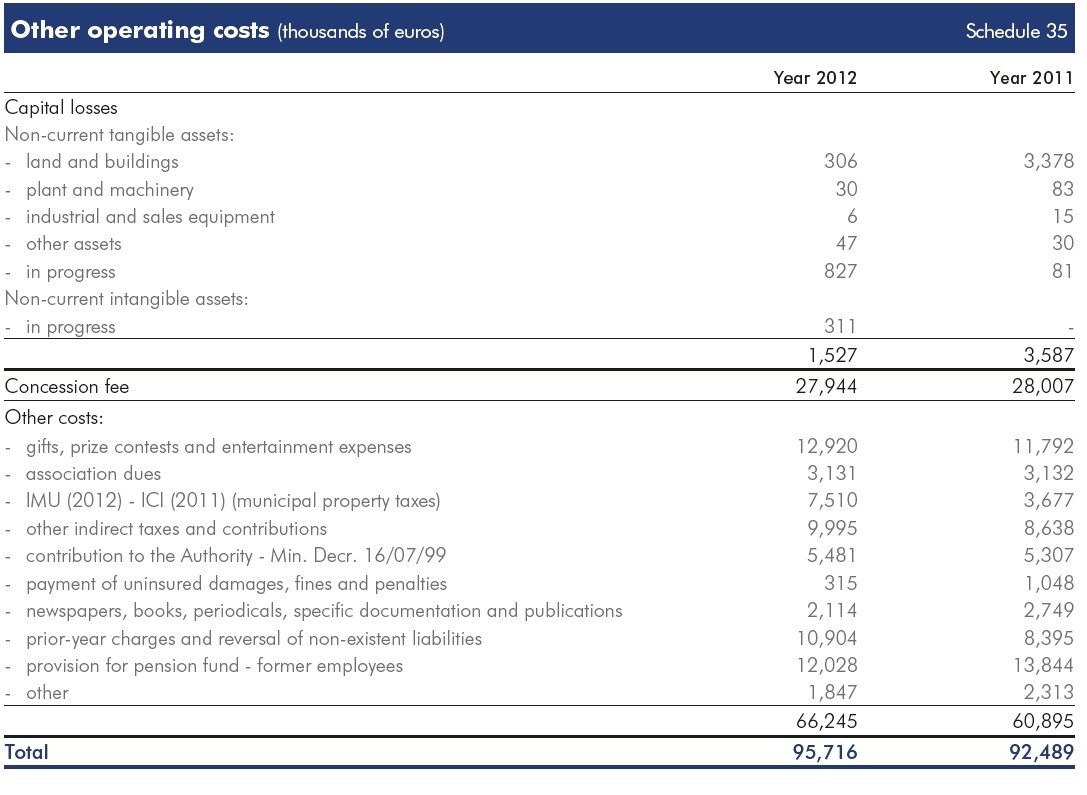
Financial income and expense
Income from equity investments: no value (80,189 thousand euros at 31 December 2011), as shown in Schedule 36. The
dividends collected in 2012 from Tivù Srl (385 thousand euros) and Euronews (166 thousand euros) following the adoption of
the equity method, already highlighted in the previous points, were deducted from the value of the investment, without effects
on the income statement.
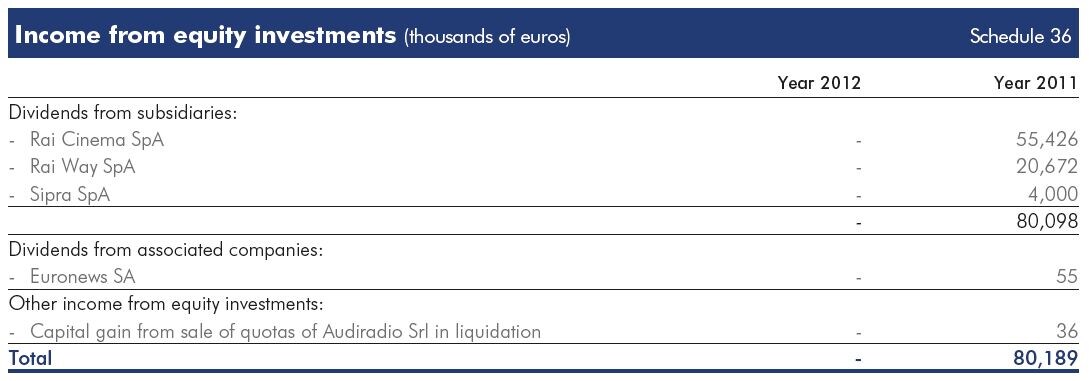
Other financial income: this amounts to 8,747 thousand euros (7,785 thousand euros at 31 December 2011) broken down
as follows:
• from non-current receivables: booked for 16 thousand euros for interest income on guarantee deposits;
• from non-current securities other than equity investments: booked for 90 thousand euros and referring to interest earned;
• financial income other than the above: this amounts to 8,641 thousand euros and mainly relates to interest on current
receivables as shown directly in the income statement and detailed even further in Schedule 37.
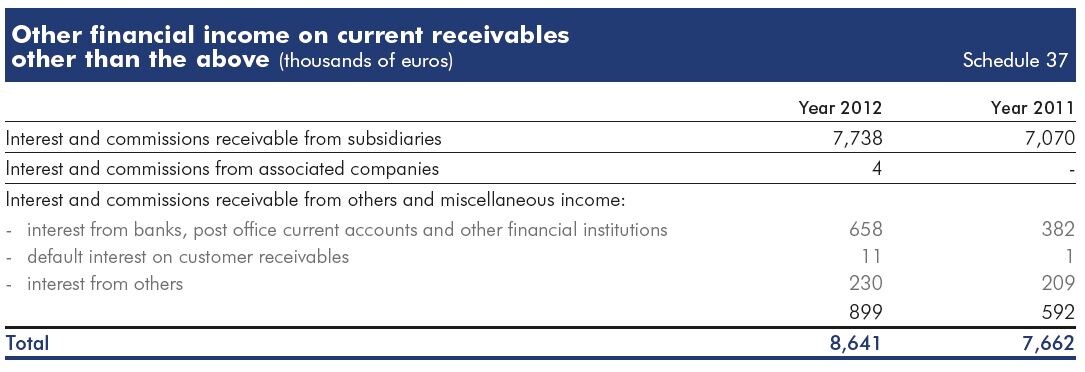
Interest and other financial charges: these amount to 15,708 thousand euros (9,815 thousand euros at 31 December
2011). They relate to interest expense, commission expense for financial services received and other charges for financial
operations, as shown directly in the income statement and in further detail in Schedule 38.
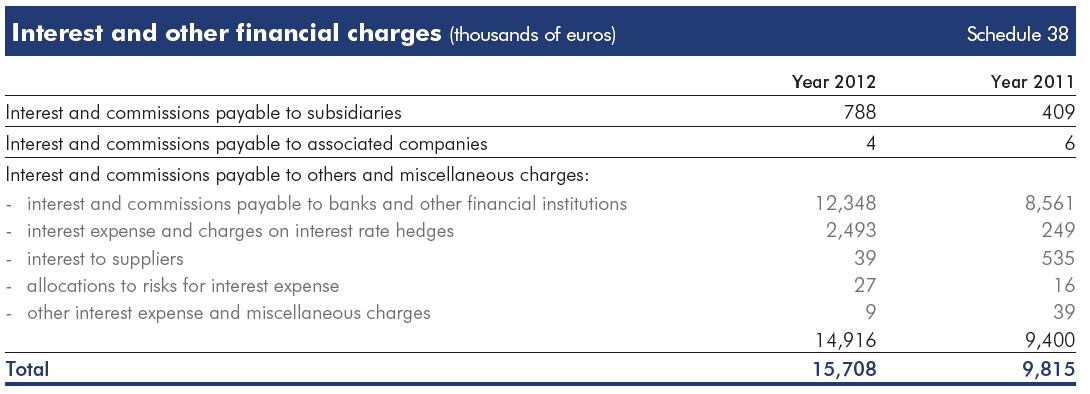
Foreign exchange gains and losses: these show a gain of 3,100 thousand euros (1,415 thousand euros at 31 December
2011), representing the balance of foreign exchange charges and premiums on foreign currency hedge transactions as well
as the effect of translating the value of payables and receivables in foreign currencies at year-end exchange rates or the rate
in force at the time of the hedge in the case of exchange risk hedges, as detailed further in Schedule 39.

Value adjustments to financial assets
Revaluations: these amount to 24,790 thousand euros (2,677 thousand euros at 31 December 2011) and express the
income from revaluations of financial assets as a consequence of net gains from investments, recorded during the year for
24,761 thousand euros (Schedule 3 bis shows the breakdown by company), and of value adjustments of non-current assets
for 29 thousand euros.
Writedowns: these total 762 thousand euros (6,654 thousand euros at 31 December 2011). They comprise writedowns of
non-current financial assets following losses incurred for the year by the investee companies for 374 thousand euros, and of
value adjustments of non-current receivables for 388 thousand euros.
Exceptional income and expense
The caption is comprised of expenses for 62,200 thousand euros (4,786 thousand euros at 31 December 2011) and income
of 13,421 thousand euros (14 thousand euros at 31 December 2011), as detailed in Schedule 40.
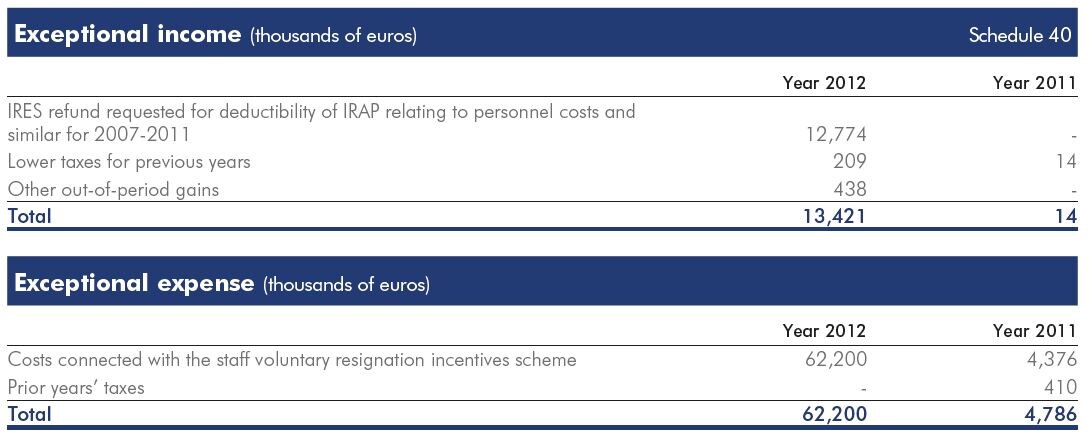
Current income taxes for the year, and deferred tax assets and liabilities
These amount to 1,703 thousand Euros. They represent the total tax charge for the year and are made up as follows:

The following table shows the origin and effects of deferred tax items during the year.
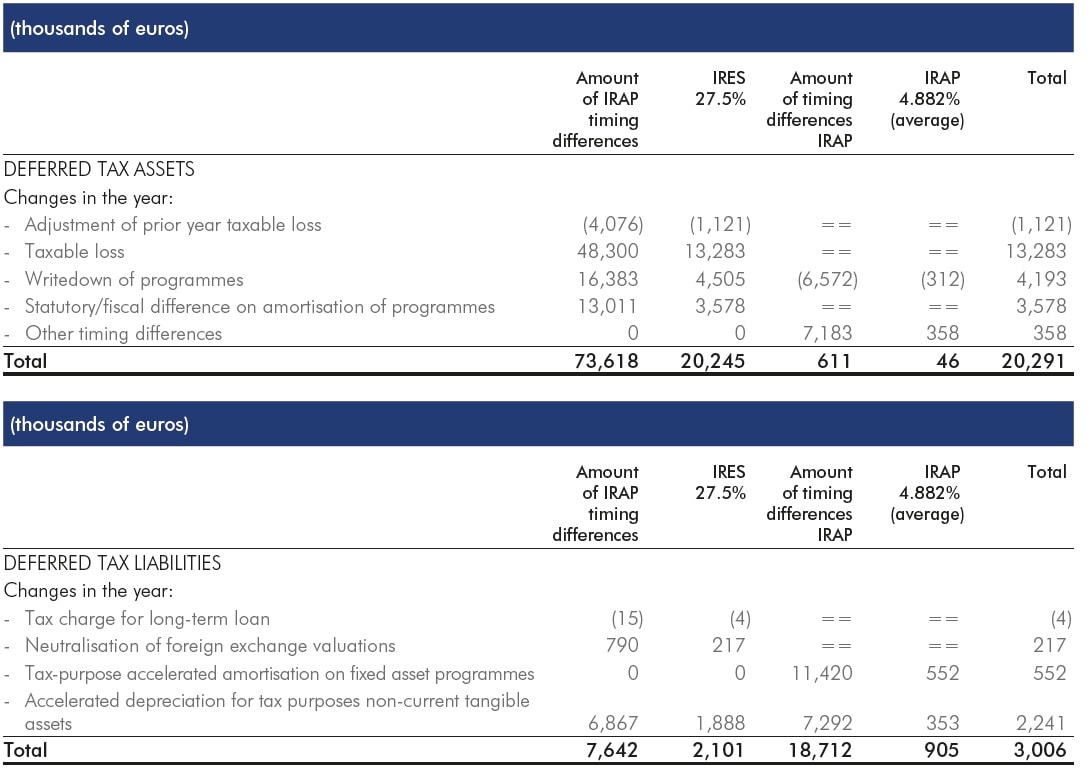
The following table presents the estimated reconciliation between the statutory result for the year and the taxable amount for
IRES and IRAP purposes.
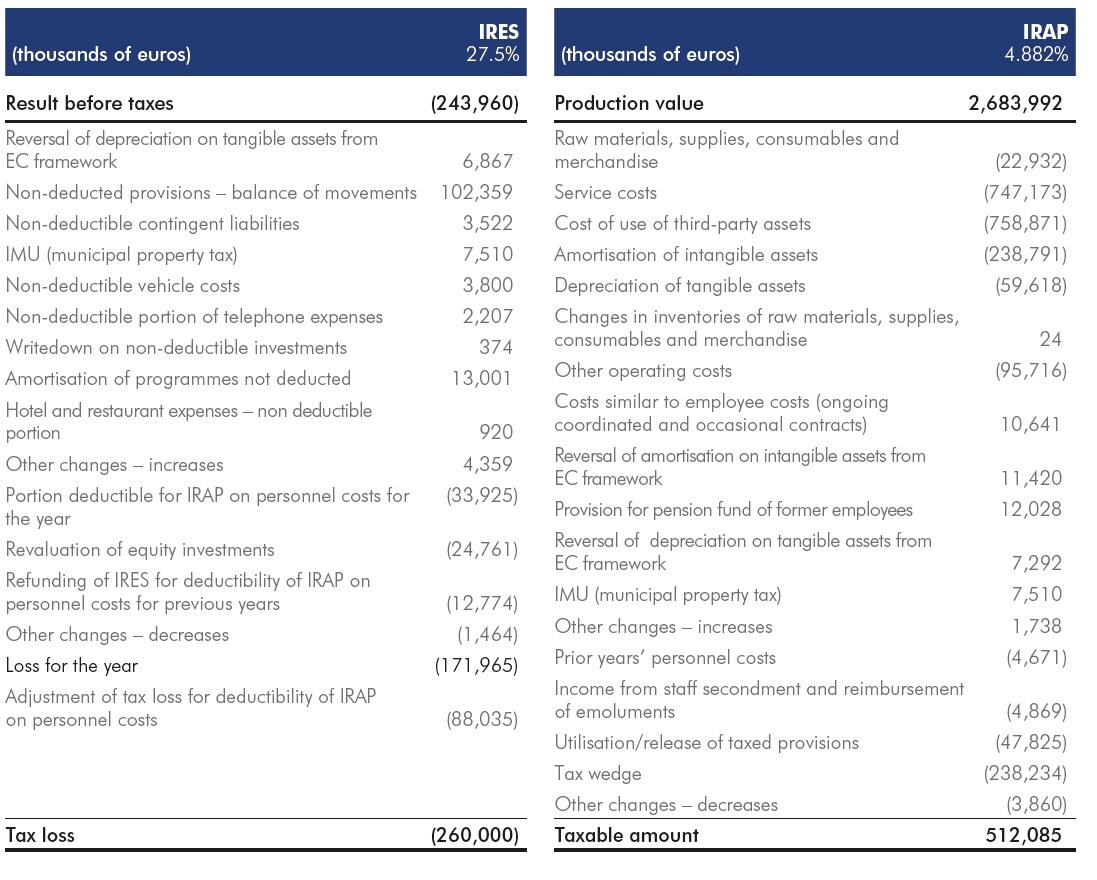
On the taxable amount for IRAP, current taxes of 25,000 thousand euros have been calculated.
7) Result for the year
The year closed with a loss of 245,662,838.10 euros.
8) Other information
As regards related party disclosures, no significant transactions took place outside the normal market conditions. For details
on relations with Group companies, see the Report on Operations.
For important events occurring after the closing date, see the Report on Operations.
 |
 |